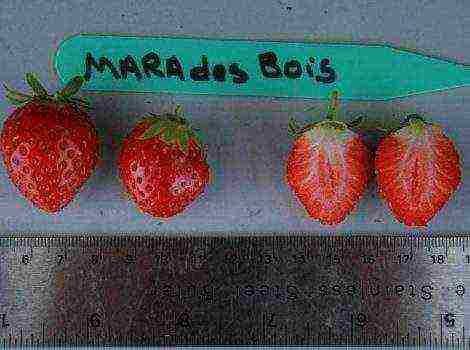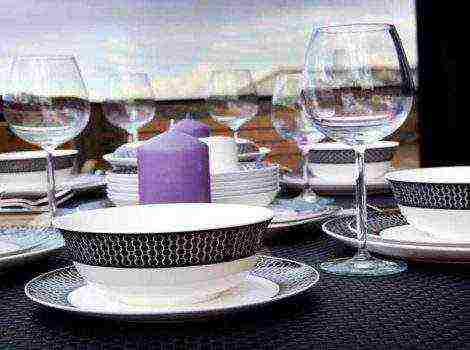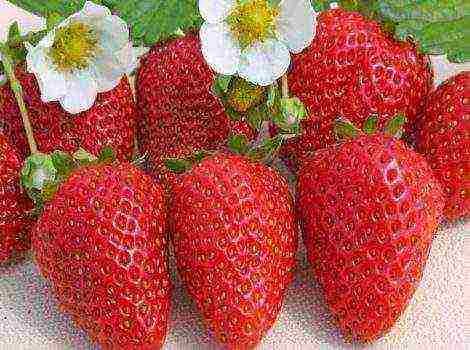Content [show]
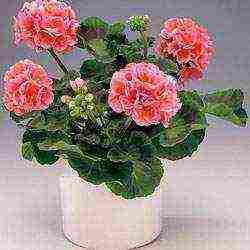 For almost a century, breeders all over the world have been breeding new and new varieties of pelargonium. Thanks to their labors, an incredibly large number of different varieties and varieties of this ornamental plant were obtained. The culture is not overly demanding on growing conditions and, with proper care, will surely answer you with lush, luxurious flowering. For your attention detailed information about zonal pelargonium, as well as its best varieties (photos with names and descriptions are attached).
For almost a century, breeders all over the world have been breeding new and new varieties of pelargonium. Thanks to their labors, an incredibly large number of different varieties and varieties of this ornamental plant were obtained. The culture is not overly demanding on growing conditions and, with proper care, will surely answer you with lush, luxurious flowering. For your attention detailed information about zonal pelargonium, as well as its best varieties (photos with names and descriptions are attached).
About zonal pelargonium
This is one of the most common plant groups, represented by a large number of species and varieties. Zonal varieties belonging to the group of the same name are considered for the reason that they have a certain zone on the leaves, painted in a different color (most often in the form of a small ring-shaped or rounded spot). Pelargonium zonal is perfect for growing not only indoors, but also in open areas.
The variety is represented by an erect, fairly branched and powerful bush, densely covered with foliage. The bush is covered with small lush umbrella flowers. The leaves are heavily pubescent, have a specific smell. Zonal pelargoniums are also divided into several varieties, depending on the number of petals on the flowers. So, they are 5-8-petal (sometimes more).
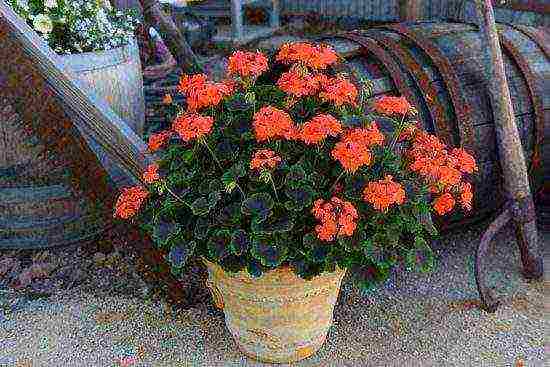
Pelargonium is an unpretentious plant
Zonal pelargonium is a plant that is rather unpretentious to growing conditions, but quite demanding to care for. It is necessary to provide it with the required amount of solar heat and light, nutritious and regular feeding, saturate it with moisture, etc.
Advice. During the winter, it is necessary to provide the plant with sufficient access to cool air. If this is not possible, remove as many bare shoots from the plant as possible in the spring.
Basic classification of zonal pelargonium
Zonal pelargonium, in turn, can be conditionally divided into several more subgroups:
- Rosaceae. All varieties presented in this category have luxurious double flowers, outwardly very reminiscent of classic roses.
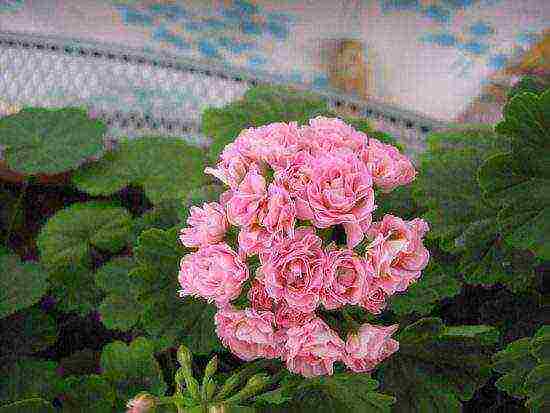
Rosaceous pelargonium
- Tulip-shaped.Flowers of varieties from this group are small flowers collected in inflorescences. Outwardly, they resemble small unopened tulip-shaped buds. The petals of tulip-shaped pelargoniums differ in a rather unusual appearance: they are slightly inclined inward and lowered, as if they have already begun to wither. This in no way suggests that the plants are really withering. In fact, the sluggish appearance of the petals is a specific feature of the variety.
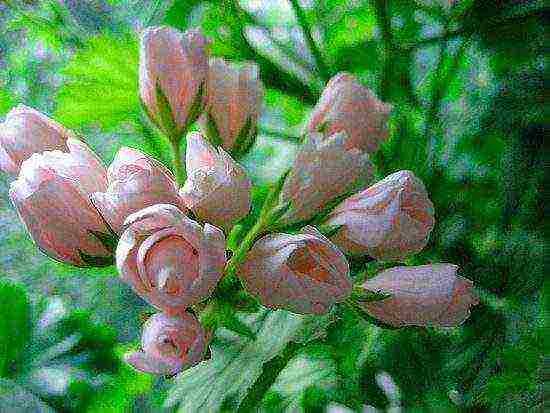
Tulip pelargonium
- Star-shaped. Star-shaped pelargoniums are completely different from their "fellow tribesmen": the flowers of these dwarf plants have an unusual shape of a pointed star. Moreover, quite often the two largest petals have an elongated shape with a sharp end, which makes them different from the rest.

Star pelargonium
- Cloves. The varieties presented in this category are outwardly very similar to garden carnations: they are just as large, with carved petals of a fairly bright shade.

Clove pelargonium
- Cactus. A fairly rare variety of zonal pelargonium, which is represented by a fairly large, strongly leafy bush. The leaves are wide, bright green. The flowers of cactus varieties look quite unusual: their petals seem to be rolled into narrow tubes. Quite often they have a slightly "disheveled" appearance.

Cactus pelargonium
- Deacons. Quite young hybrids that appeared on the world flower market less than 50 years ago. They are represented by a very compact, profusely flowering bush with a small rosette of delicate peach, pink or red shades.

Pelargonium deacon
Let's take a closer look at several of the best representatives in each category of the zonal variety of pelargonium. Among the most popular pink varieties there are several:
- April Snow is a neat dwarf plant with small double pink flowers in the form of roses.
- Denise is a vigorous plant that every year is covered with a large double head of pink or peach color.
- Monseruds Rosen is not easy to grow - it is quite difficult to form the necessary shape, it has a luxurious burgundy flowering.
Among the most popular star varieties pelargonium can be distinguished as follows:
- Aunty Pam - Stellаr. The variety is represented by a rather compact well-branched bush, densely covered with luxurious bright pink flower rosettes. Externally, the flower petals resemble a small double carnation.
- Borthwood - Stellаr. Another excellent star-shaped variety, represented by a strongly flowering dwarf bush, the leaves of which are slightly reminiscent of frog legs in shape.
- Fandango. Quite an unusual variety, the flowers of which look slightly "shabby": the shape of the petals is a little torn, with indistinct edges. The flowering of plants is abundant, lush, the flowers are distinguished by a pleasant soft coral shade.
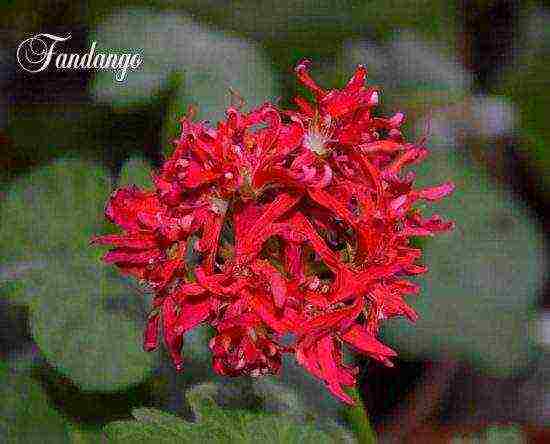
Pelargonium Fandango
Among cactus varieties pelargoniums include the following:
- Fascination (the petals of the plant are quite long, with the edges bent downward, which makes their appearance very extravagant, reminiscent of a little human nails);
- Noel (the petals of the flowers of the plant have a delicate white color and a twisted shape, a pinkish anther rises in the center).
Advice. In order to grow a luxurious, magnificently blooming pelargonium in your home, it is necessary to periodically prune its branches (it is advisable to carry out this procedure in the autumn period). This will speed up the growth of the plant and improve its appearance.
This concludes our acquaintance with one of the varieties of such an unusual and pleasant plant to grow as zonal pelargonium. Good luck!
Pelargonium varieties: video
Author of the publication
0 Comments: 100Publications: 6958Registration: 05-07-2015
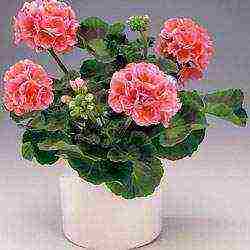 For almost a century, breeders all over the world have been breeding new and new varieties of pelargonium. Thanks to their labors, an incredibly large number of different varieties and varieties of this ornamental plant were obtained. The culture is not overly demanding on growing conditions and, with proper care, will surely answer you with lush, luxurious flowering. For your attention detailed information about zonal pelargonium, as well as its best varieties (photos with names and descriptions are attached).
For almost a century, breeders all over the world have been breeding new and new varieties of pelargonium. Thanks to their labors, an incredibly large number of different varieties and varieties of this ornamental plant were obtained. The culture is not overly demanding on growing conditions and, with proper care, will surely answer you with lush, luxurious flowering. For your attention detailed information about zonal pelargonium, as well as its best varieties (photos with names and descriptions are attached).
About zonal pelargonium
This is one of the most common plant groups, represented by a large number of species and varieties. Zonal varieties belonging to the group of the same name are considered for the reason that they have a certain zone on the leaves, painted in a different color (most often in the form of a small ring-shaped or rounded spot). Pelargonium zonal is perfect for growing not only indoors, but also in open areas.
The variety is represented by an erect, fairly branched and powerful bush, densely covered with foliage. The bush is covered with small lush umbrella flowers. The leaves are heavily pubescent, have a specific smell. Zonal pelargoniums are also divided into several varieties, depending on the number of petals on the flowers. So, they are 5-8-petal (sometimes more).
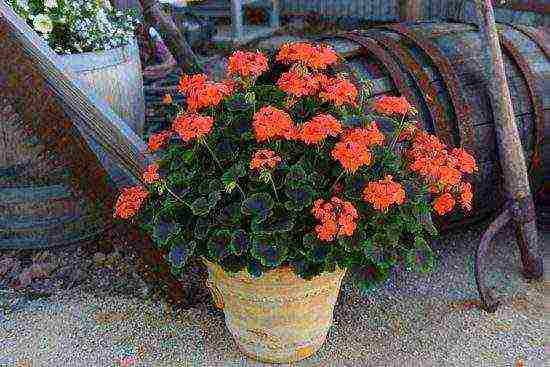
Pelargonium is an unpretentious plant
Zonal pelargonium is a plant that is rather unpretentious to growing conditions, but quite demanding to care for. It is necessary to provide it with the required amount of solar heat and light, nutritious and regular feeding, saturate it with moisture, etc.
Advice. During the winter, it is necessary to provide the plant with sufficient access to cool air. If this is not possible, remove as many bare shoots from the plant as possible in the spring.
Basic classification of zonal pelargonium
Zonal pelargonium, in turn, can be conditionally divided into several more subgroups:
- Rosaceae. All varieties presented in this category have luxurious double flowers, outwardly very reminiscent of classic roses.
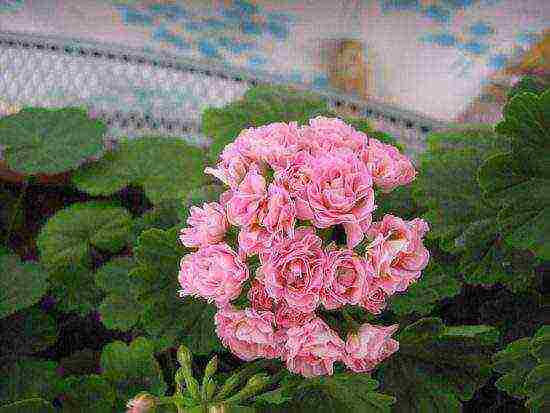
Rosaceous pelargonium
- Tulip-shaped. Flowers of varieties from this group are small flowers collected in inflorescences. Outwardly, they resemble small unopened tulip-shaped buds. The petals of tulip-shaped pelargoniums differ in a rather unusual appearance: they are slightly inclined inward and lowered, as if they have already begun to wither. This in no way suggests that the plants are really withering. In fact, the sluggish appearance of the petals is a specific feature of the variety.
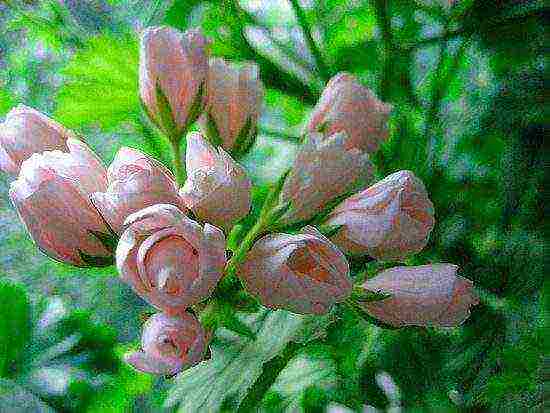
Tulip pelargonium
- Star-shaped. Star-shaped pelargoniums are completely different from their "fellow tribesmen": the flowers of these dwarf plants have an unusual shape of a pointed star. Moreover, quite often the two largest petals have an elongated shape with a sharp end, which makes them different from the rest.

Star pelargonium
- Cloves. The varieties presented in this category are outwardly very similar to garden carnations: they are just as large, with carved petals of a fairly bright shade.

Clove pelargonium
- Cactus. A fairly rare variety of zonal pelargonium, which is represented by a fairly large, strongly leafy bush. The leaves are wide, bright green. The flowers of cactus varieties look quite unusual: their petals seem to be rolled into narrow tubes. Quite often they have a slightly "disheveled" appearance.
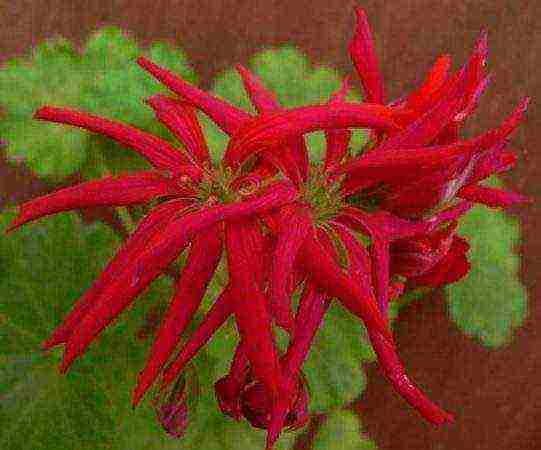
Cactus pelargonium
- Deacons. Quite young hybrids that appeared on the world flower market less than 50 years ago. They are represented by a very compact, profusely flowering bush with a small rosette of delicate peach, pink or red shades.
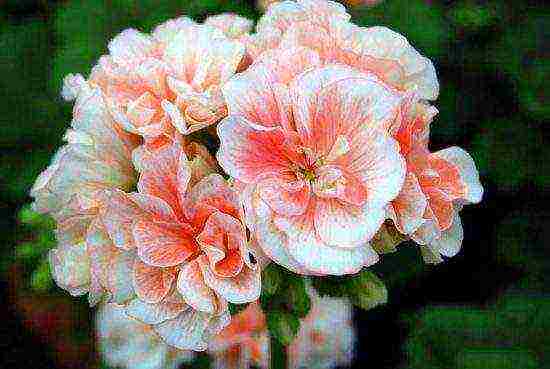
Pelargonium deacon
Let's take a closer look at several of the best representatives in each category of the zonal variety of pelargonium.Among the most popular pink varieties there are several:
- April Snow is a neat dwarf plant with small double pink flowers in the form of roses.
- Denise is a vigorous plant that every year is covered with a large double head of pink or peach color.
- Monseruds Rosen is not easy to grow - it is quite difficult to form the necessary shape, it has a luxurious burgundy flowering.
Among the most popular star varieties pelargonium can be distinguished as follows:
- Aunty Pam - Stellаr. The variety is represented by a rather compact well-branched bush, densely covered with luxurious bright pink flower rosettes. Externally, the flower petals resemble a small double carnation.
- Borthwood - Stellаr. Another excellent star-shaped variety, represented by a strongly flowering dwarf bush, the leaves of which are slightly reminiscent of frog legs in shape.
- Fandango. Quite an unusual variety, the flowers of which look slightly "shabby": the shape of the petals is a little torn, with indistinct edges. The flowering of plants is abundant, lush, the flowers are distinguished by a pleasant soft coral shade.
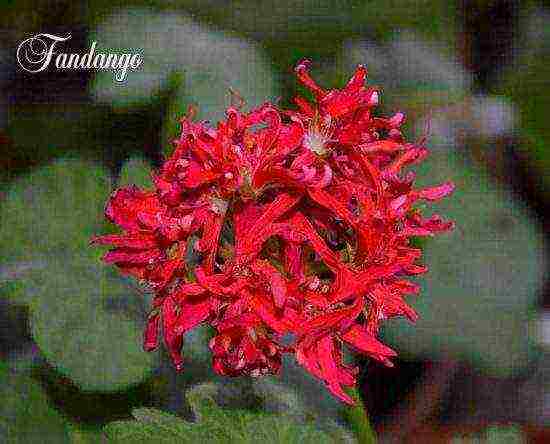
Pelargonium Fandango
Among cactus varieties pelargoniums include the following:
- Fascination (the petals of the plant are quite long, with the edges bent downward, which makes their appearance very extravagant, reminiscent of a little human nails);
- Noel (the petals of the flowers of the plant have a delicate white color and a twisted shape, a pinkish anther rises in the center).
Advice. In order to grow a luxurious, magnificently blooming pelargonium in your home, it is necessary to periodically prune its branches (it is advisable to carry out this procedure in the autumn period). This will speed up the growth of the plant and improve its appearance.
This concludes our acquaintance with one of the varieties of such an unusual and pleasant plant to grow as zonal pelargonium. Good luck!
Pelargonium varieties: video
Among the most attractive garden and indoor plants, zonal pelargonium occupies a separate place. This flower is a frequent visitor to government agencies and parks. However, there are so many varieties of zonal pelargonium that you can always pick up a flower for your apartment.
Zone View History
Geranium of the genus Pelargonium zonal was first discovered in the middle of the last millennium on the African continent. The plant attracted the discoverers with its bright flowers and unusual boll shape. This shape resembled the beak of a stork, which is why the new species was given the name Pelargoniums - derived from the Greek "πελαργός", which means "stork". And the word "zonal" appeared in the name due to the special color of the leaf plate - in spring and summer, a small zone appears on it, painted in a different color. Thus, the Latin name for the zonal geranium was formed - Zonal pelargoniums.
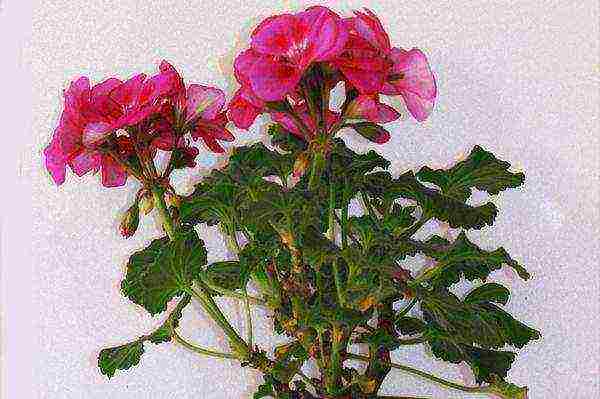
For the first time, zonal pelargonium came to the territory of Europe from Africa in the 18th century - it was brought by British sailors to their homeland. There the flower gained wide popularity and until the beginning of the twentieth century remained a symbol not only of the Victorian era, but also of the English bourgeois life in principle. At the time when the popularity of the plant in the British Isles began to fall, zonal geranium was already known throughout Eurasia, due to which its old varieties were actively bred and new ones were bred.
To date, more than 350 varieties of Zonal pelargoniums are known. The flower is grown both indoors and outdoors, and the variety of colors allows you to choose a crop option for every taste.
The best varieties
As already mentioned, zonal pelargonium has more than three hundred species. The most common are:
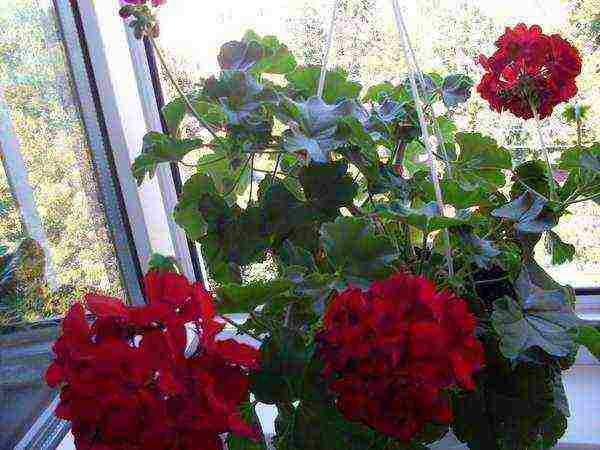
- Calliope Dark Red is a newly bred hybrid. The authors of this variety in the description must indicate the magnificent view of Calliope Dark Red - rich red double buds are located on a medium-sized shrub;
- another medium-sized variety Rafaella differs from Calliope Dark Red in larger inflorescences and a variety of shades - from pale pink to lilac;
- The Violet chandelier blooms with purple buds from May to October. This variety is suitable for both the street and the home, and with proper care, it will delight you with large inflorescences sitting on bright green stems;
- Pelargoniums of the PAC group (we know as PAK) are more expensive hybrids. Most of them were bred in the last two decades. Varieties of PAK are distinguished by a wide variety of colors and shapes - flowers similar to roses and classic geraniums, white, blue and all shades of red. In our country, the most famous geranium hybrids under the following names are PAC Fireworks Red, PAC Fireworks Red-White, PAC Salmon Princess, PAC Viktor Improved , PAC Viva Carolina;
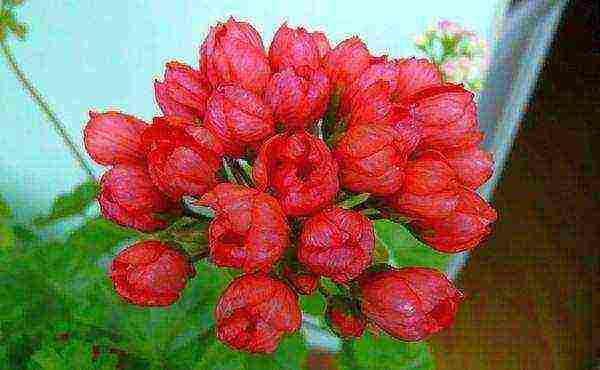
- incredibly beautiful hybrid Red Pandora belongs to tulip varieties. Inflorescences of Red Pandora resemble a set of small tulips of a delicate scarlet color. The variety blooms for a long time and does not require serious care;
- Pelargonium Montevideo grows into huge peony buds of a pale salmon color. The plant is medium-sized and suitable for growing in an apartment;
- Unicorn Zonartic Rose is a vigorous cross between the golden Lara Zonartic and the purple Lara Suzanne. The result is a plant with pale purple petals and large double leaves;
- another group of pelargoniums - Deacons. In this group, there are plants of various shades - platinum, orange, white, burgundy and others. The flowers are low, with sparse foliage. A number of varieties are bred in Italian Tuscany (Cato, Claudio, Eric, Bernd), other European countries are the homeland of others (Cupid, Emma Hawsley).
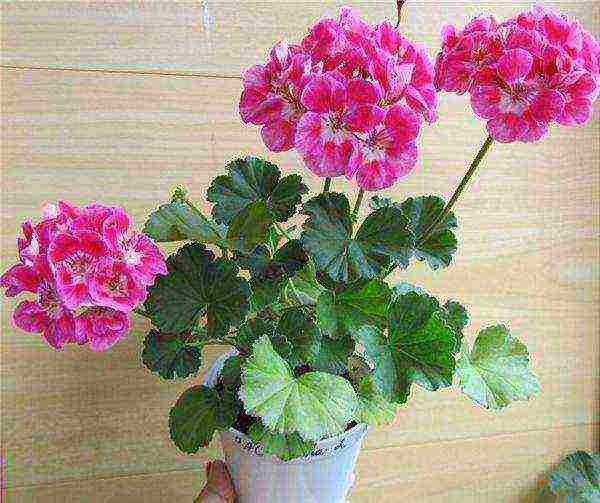
Features of growing and care
It is very easy to care for zonal pelargonium. All you need to do is choose the right planting spot and determine the correct watering schedule.
Home care is the most comfortable, since it does not require sheltering the plant for the winter and fighting rodents. However, there are also some nuances here. For example, if placing pelargonium on the street in spring and early summer is almost guaranteed to provide the plant with the required amount of light, then in the room you will have to find the brightest and most calm corner of the house - preferably a southeast window. If there is no such place, in winter the flower will have to be illuminated artificially - with the help of lamps.
Also, do not forget that sunburn has a detrimental effect on the condition of the foliage - protect your plants from direct sunlight and shade flowers in time.
The home conditions of our regions are ideal for growing zonal pelargonium - comfortable temperatures for a plant are considered to be from 12 to 24 ° C, which allows the flower not to fade even in winter. The same applies to humidity: low humidity during the heating season is not a cause for concern, because pelargonium does not need to be sprayed. All they need is regular watering after the soil dries out. In winter, the frequency of soil moistening can be reduced to 1 time in 10 days.
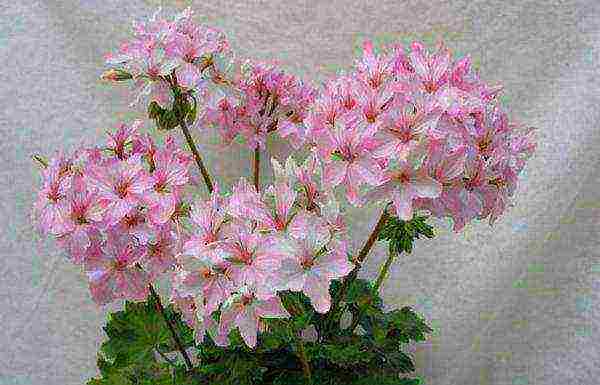
Zonal pelargoniums prefers loose soils. Special primers for this type of plants can be purchased at a flower shop or mixed by yourself. To do this, you need sheet soil, peat, charcoal and sand. All ingredients must be mixed in a 3: 1: 1: 1 ratio.
A change of soil is required for a flower once a year. When transplanting from pot to pot, the volume of the new vessel should not exceed the previous one by more than 15%. The plant is planted in the ground in the middle of spring and removed from there in the fall.
Zonal geranium does not need frequent feeding - it is enough to feed the plant with potassium-phosphate fertilizers before flowering, as well as mineral mixtures during the dormant period. In winter, limit feeding once every six weeks.
Pelargoniums are characterized by a high growth rate, which is why the timely formation of the bush becomes an important point. In the absence of pruning and removal of old shoots, the plant will stop blooming.Therefore, regularly remove old shoots, and also pinch the flower at points of growth no higher than above the sixth leaf.
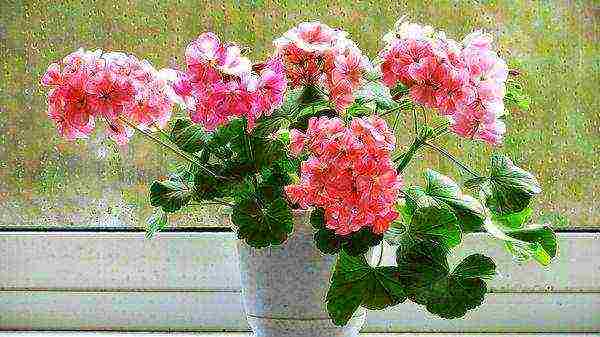
Zonal pelargonium, like other house plants, is often affected by pests and fungal diseases. In addition, improper care of the flower or its complete absence can become the cause of disease. To avoid problems, do not break the watering, transplanting and feeding regimes, and also regularly check the plant for the presence of parasites (aphids, whiteflies, spider mites).
Breeding rules
Zonal geraniums are propagated mainly in two ways - by seeds and cuttings. The first method is suitable for those who want to grow a flower from scratch. On the package with seeds it should be written at what time it is recommended to grow seedlings - most often this is done at the end of winter.
Previously, the seeds are soaked in warm water, and then the substrate is transplanted and kept in a warm, well-lit place, regularly moistening and fertilizing. By the spring, the sprouts grow so much that they can be transplanted into a pot, and in the summer such plants are able to give the first buds.

Propagation by cuttings helps to obtain the desired plant, which will be a complete copy of the mother flower. To do this, cut off the shoot from the mother plant, keep it in dry, humid conditions for a couple of days, and then, like an ordinary plant, transplant it into a pot with soil suitable for pelargonium. Previously, you can put the shoot in a glass of water and keep it there until the roots form, but the quality of growth will not change from this. It is recommended to water the young shoot regularly and keep it on a well-lit windowsill.
We wish you success in growing zonal pelargonium!
Video "Variety selection and reproduction of pelargonium"
In this video, you will learn how to choose the right pelargonium variety and propagate the plant.
 Modern varieties of pelargonium are difficult to compare with the bushes of "grandmother's" geraniums, whose scarlet or pink umbrellas proudly flaunted on the windowsills of city apartments, in the front gardens and on the balconies. Despite the fact that the plants have not become more capricious, today varieties are available to flower growers that delight with long flowering not simple, but densely double flowers, and the palette of inflorescences is unusually wide. This is evidenced by descriptions and photos of pelargonium varieties.
Modern varieties of pelargonium are difficult to compare with the bushes of "grandmother's" geraniums, whose scarlet or pink umbrellas proudly flaunted on the windowsills of city apartments, in the front gardens and on the balconies. Despite the fact that the plants have not become more capricious, today varieties are available to flower growers that delight with long flowering not simple, but densely double flowers, and the palette of inflorescences is unusually wide. This is evidenced by descriptions and photos of pelargonium varieties.
Pelargonium Pebbles
 Terry, with a lightened center, pink-crimson flowers of Pelargonium Pebbles seem even larger, since the plant itself is not too large and rightfully belongs to the category of miniature.
Terry, with a lightened center, pink-crimson flowers of Pelargonium Pebbles seem even larger, since the plant itself is not too large and rightfully belongs to the category of miniature.
 Despite the emergence of new varieties of pelargonium, a photo of this fluffy, easy-to-form bush invariably attracts the attention of flower growers who will not be disappointed when growing it on a flower bed or windowsill. The dense caps of the inflorescences look even more voluminous due to the light, almost white back of the petals.
Despite the emergence of new varieties of pelargonium, a photo of this fluffy, easy-to-form bush invariably attracts the attention of flower growers who will not be disappointed when growing it on a flower bed or windowsill. The dense caps of the inflorescences look even more voluminous due to the light, almost white back of the petals.
Pelargonium Shelk Moira
 Delicate dwarf pelargonium Shelk Moira is the first officially recognized creation of Russian breeders. The author of a spectacular plant with dense double flowers of an unusual light salmon shade and bright emerald foliage is a resident of St. Petersburg Irina Kleimova.
Delicate dwarf pelargonium Shelk Moira is the first officially recognized creation of Russian breeders. The author of a spectacular plant with dense double flowers of an unusual light salmon shade and bright emerald foliage is a resident of St. Petersburg Irina Kleimova.
 The inflorescences of this variety of pelargonium, as in the photo, are dense, the flowers are densely double, with wavy petals lightened on the back side.
The inflorescences of this variety of pelargonium, as in the photo, are dense, the flowers are densely double, with wavy petals lightened on the back side.
Pelargonium Brookside Fantasy
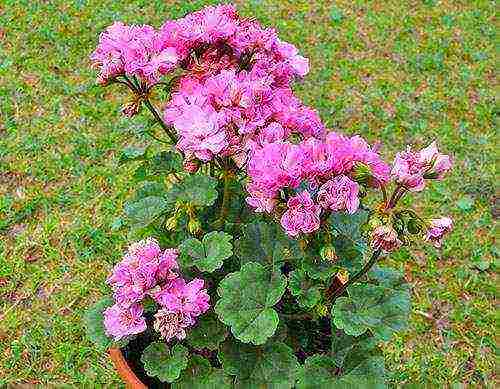 Another terry plant of the Brookside Fantasy variety is a striking representative of zonal pelargoniums. Compact bushes with rich green leaves with a clearly visible dark stripe delight with inflorescences of a delicate pink-lilac shade.
Another terry plant of the Brookside Fantasy variety is a striking representative of zonal pelargoniums. Compact bushes with rich green leaves with a clearly visible dark stripe delight with inflorescences of a delicate pink-lilac shade.
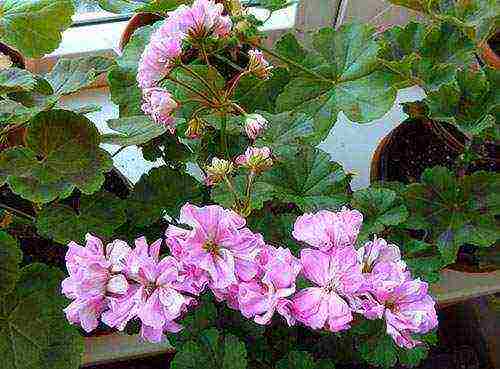 At the stage when the buds are still opening, closer to the center, the petals have a slight green glow, then their reverse side acquires a pink-cream color, slightly lighter than the entire inflorescence. The flower caps are large, commensurate with the inflorescences on standard bushes, although this pelargonium is a real miniature.
At the stage when the buds are still opening, closer to the center, the petals have a slight green glow, then their reverse side acquires a pink-cream color, slightly lighter than the entire inflorescence. The flower caps are large, commensurate with the inflorescences on standard bushes, although this pelargonium is a real miniature.
Pelargonium Bold Carmine
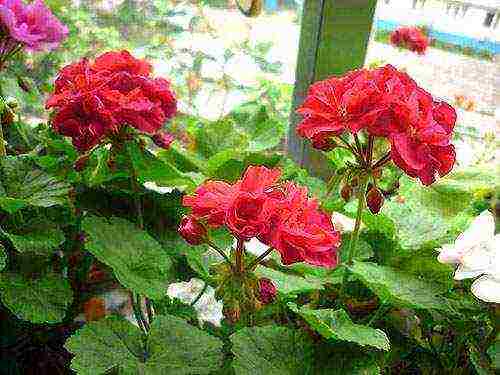 Red-crimson flowers, as in the photo, pelargonium varieties Bold Carmine can be attributed to semi-double or double. The plant itself is compact, accepts feeding well and willingly produces elongated peduncles with caps of carmine flowers.
Red-crimson flowers, as in the photo, pelargonium varieties Bold Carmine can be attributed to semi-double or double. The plant itself is compact, accepts feeding well and willingly produces elongated peduncles with caps of carmine flowers.
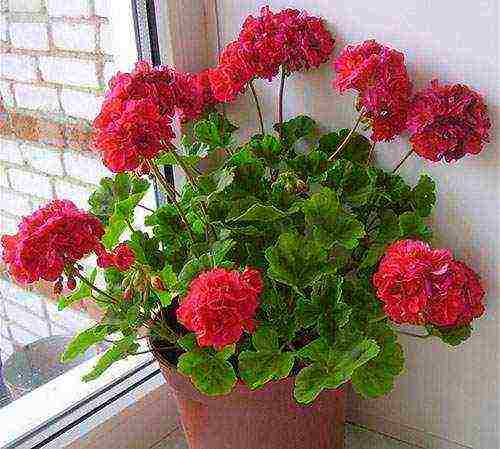 The back of the petals of this variety is lighter in color. The foliage is bright, with a noticeable concentric stripe in the middle of the leaf blade.
The back of the petals of this variety is lighter in color. The foliage is bright, with a noticeable concentric stripe in the middle of the leaf blade.
Pelargonium Saxdalens Selma
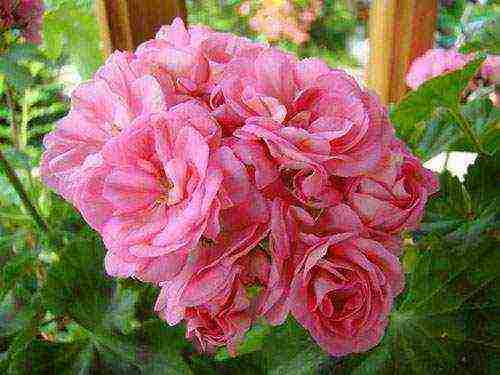 Zonal pelargoniums Saxdalens Selma form a large, strong bush that stands out not only with powerful shoots, but also with voluminous beautiful inflorescences consisting of pale pink flowers. Plants of this variety bloom beautifully and respond to care. The bush is small, easily branching.
Zonal pelargoniums Saxdalens Selma form a large, strong bush that stands out not only with powerful shoots, but also with voluminous beautiful inflorescences consisting of pale pink flowers. Plants of this variety bloom beautifully and respond to care. The bush is small, easily branching.
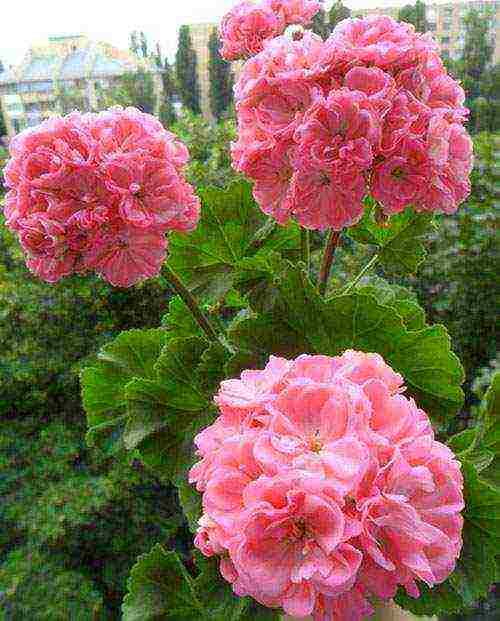 Many growers pay attention to the unusual structure of spectacular pink flowers, more reminiscent of the rosaceous varieties.
Many growers pay attention to the unusual structure of spectacular pink flowers, more reminiscent of the rosaceous varieties.
Pelargonium Mimi
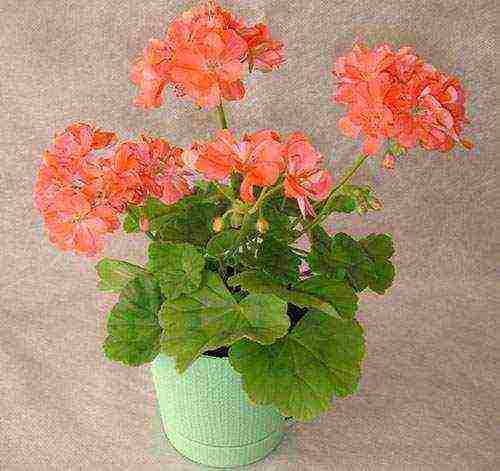 Light, airy and very large inflorescences of this variety of pelargonium, as in the photo, are easy to recognize by the amazingly beautiful pink-salmon shade of flowers.
Light, airy and very large inflorescences of this variety of pelargonium, as in the photo, are easy to recognize by the amazingly beautiful pink-salmon shade of flowers.
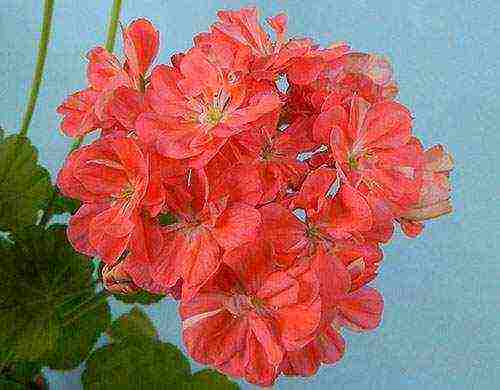 But this is not the only advantage of the variety. The foliage of the pelargonium has a golden green color. The bushes are of slow growth and compactness.
But this is not the only advantage of the variety. The foliage of the pelargonium has a golden green color. The bushes are of slow growth and compactness.
Pelargonium le Pirat
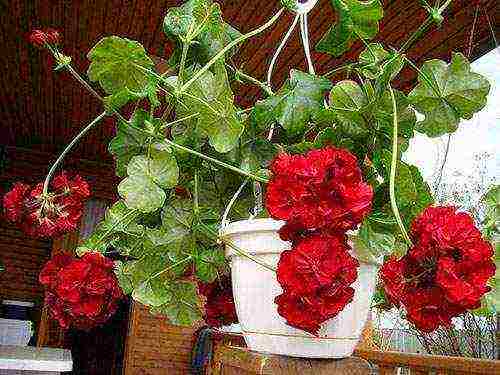 Terry ivy-leaved pelargonium le Pirat amazes with the abundance and splendor of inflorescences. The flowers of this variety have a velvety deep red color and in shape, at the beginning of flowering, very much resemble blossoming roses.
Terry ivy-leaved pelargonium le Pirat amazes with the abundance and splendor of inflorescences. The flowers of this variety have a velvety deep red color and in shape, at the beginning of flowering, very much resemble blossoming roses.
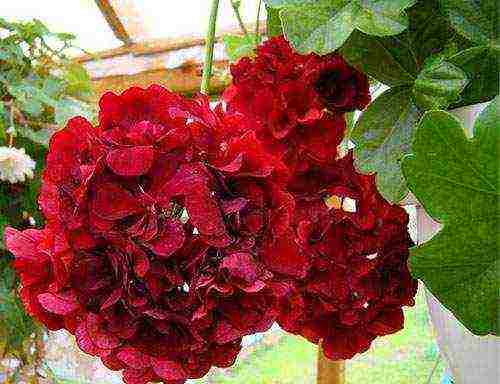 Pelargonium differs in that the flowers do not fall off for a long time, and the plants can be used as an ampelous culture to decorate a veranda or garden.
Pelargonium differs in that the flowers do not fall off for a long time, and the plants can be used as an ampelous culture to decorate a veranda or garden.
Pelargonium Noel Gordon
 Since the shape of the densely double flowers of Noel Gordon pelargonium is very reminiscent of roses, the plant can also be attributed to the rosy varieties. The bushes of this zonal pelargonium are compact and densely foliated.
Since the shape of the densely double flowers of Noel Gordon pelargonium is very reminiscent of roses, the plant can also be attributed to the rosy varieties. The bushes of this zonal pelargonium are compact and densely foliated.
 Due to the abundance of large pink flowers with wavy petals, dense inflorescences of this variety are very decorative and do not crumble for a long time.
Due to the abundance of large pink flowers with wavy petals, dense inflorescences of this variety are very decorative and do not crumble for a long time.
Pelargonium PAC Viva Maria
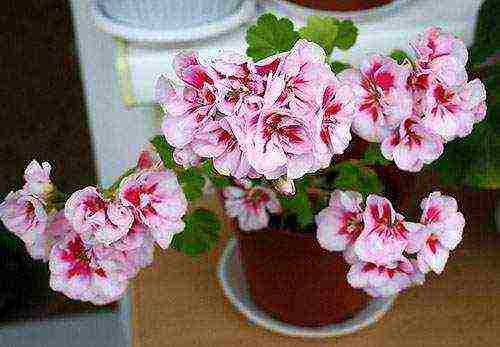 Pelargonium PAC Viva Maria with German roots, like its relatives, blooms profusely and for a long time, while the bushes are very compact, and the inflorescences are luxurious and large.
Pelargonium PAC Viva Maria with German roots, like its relatives, blooms profusely and for a long time, while the bushes are very compact, and the inflorescences are luxurious and large.
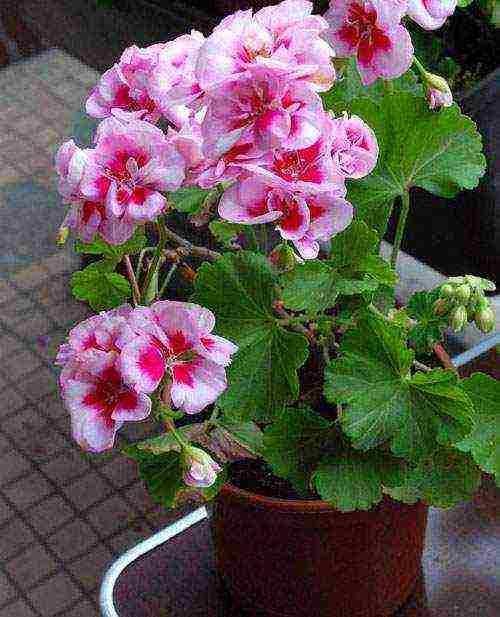 The flowers of this variety are easily recognizable among the mass of other inflorescences by their white color with a bright crimson spot at the base of each petal. As a result, simple or semi-double flowers of pelargonium differ favorably from the general row, and plants of this variety are worthy of becoming valuable specimens in the collections of both connoisseurs of the species and beginners.
The flowers of this variety are easily recognizable among the mass of other inflorescences by their white color with a bright crimson spot at the base of each petal. As a result, simple or semi-double flowers of pelargonium differ favorably from the general row, and plants of this variety are worthy of becoming valuable specimens in the collections of both connoisseurs of the species and beginners.
Pelargonium Powder Puff
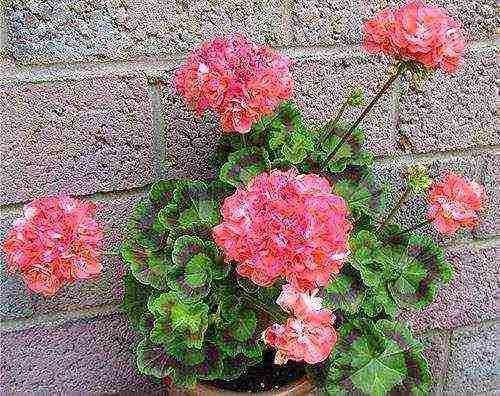 The decorativeness of the Powder Puff zonal pelargonium is achieved due to very dense salmon-colored inflorescences and beautiful leaves with a clearly defined contrasting stripe.
The decorativeness of the Powder Puff zonal pelargonium is achieved due to very dense salmon-colored inflorescences and beautiful leaves with a clearly defined contrasting stripe.
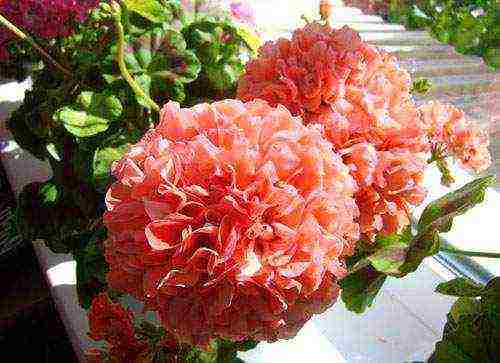 The petals are lighter on the back than on the top. Plants are small in size, which will be appreciated by flower growers who have only indoor window sills at their disposal.
The petals are lighter on the back than on the top. Plants are small in size, which will be appreciated by flower growers who have only indoor window sills at their disposal.
Pelargonium Lake
 The salmon color of the wavy petals of Lake pelargonium becomes almost white to the edge, and the color appears in full force only towards the center of the large double flowers. Moreover, for a brighter flowering, the plants are recommended to be exposed to the sun; in the shade, the colors fade noticeably.
The salmon color of the wavy petals of Lake pelargonium becomes almost white to the edge, and the color appears in full force only towards the center of the large double flowers. Moreover, for a brighter flowering, the plants are recommended to be exposed to the sun; in the shade, the colors fade noticeably.
 The plant itself belongs to the standard zonal varieties and requires careful shaping. The leaves of this variety of pelargonium, as in the photo, are very elegant due to the wide contrasting border of a brownish-green hue.
The plant itself belongs to the standard zonal varieties and requires careful shaping. The leaves of this variety of pelargonium, as in the photo, are very elegant due to the wide contrasting border of a brownish-green hue.
Pelargonium Ludwigsburger Flair
 The dwarf pelargonium Ludwigsburger Flair blooms readily and profusely, but for the plant to really look like a miniature one, careful work will be required from the grower when shaping the bush.
The dwarf pelargonium Ludwigsburger Flair blooms readily and profusely, but for the plant to really look like a miniature one, careful work will be required from the grower when shaping the bush.
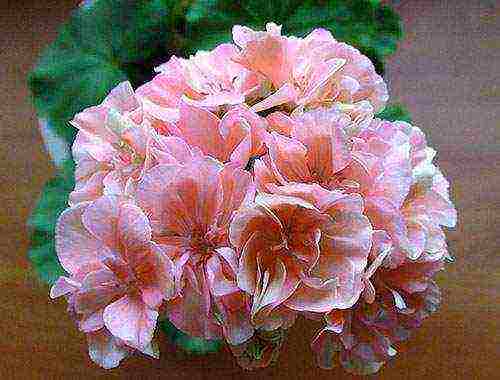 Terry beautiful flowers of this variety have a pink color, which becomes brighter towards the center and becomes almost white or greenish towards the corrugated edge.
Terry beautiful flowers of this variety have a pink color, which becomes brighter towards the center and becomes almost white or greenish towards the corrugated edge.
Pelargonium Mallorca
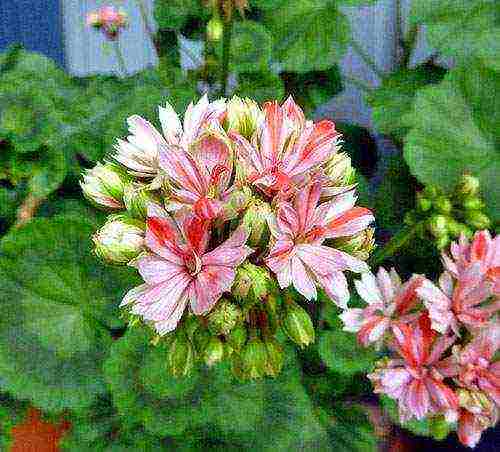 Gorgeous, unusual in shape, the flowers of the Mallorca zonal pelargonium make this variety to be attributed to cactus.The peculiarity of the flowers is a lot of jagged petals, pointed along the edge, combining red, white and greenish stripes in color.
Gorgeous, unusual in shape, the flowers of the Mallorca zonal pelargonium make this variety to be attributed to cactus.The peculiarity of the flowers is a lot of jagged petals, pointed along the edge, combining red, white and greenish stripes in color.
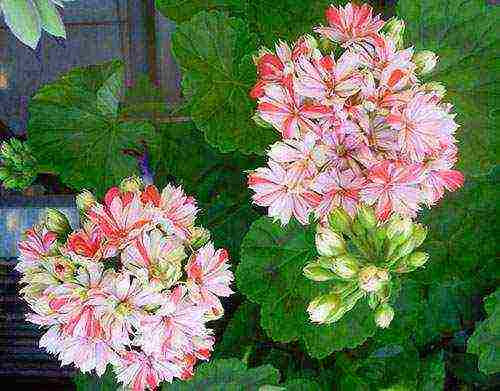 The plant is compact, forms new inflorescences easily and for a long time. If the bush is in a lighted place, the plant remains small, and in the shade it begins to stretch to standard pelargonium.
The plant is compact, forms new inflorescences easily and for a long time. If the bush is in a lighted place, the plant remains small, and in the shade it begins to stretch to standard pelargonium.
Pelargonium Dowepoint
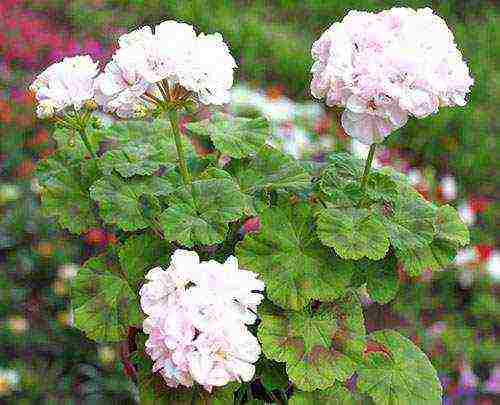 Leaves with a neat decorative border and the barely pink flowers of Dowepoint Pelargonium distinguish this luxurious variety from the many terry plants of this type that exist today.
Leaves with a neat decorative border and the barely pink flowers of Dowepoint Pelargonium distinguish this luxurious variety from the many terry plants of this type that exist today.
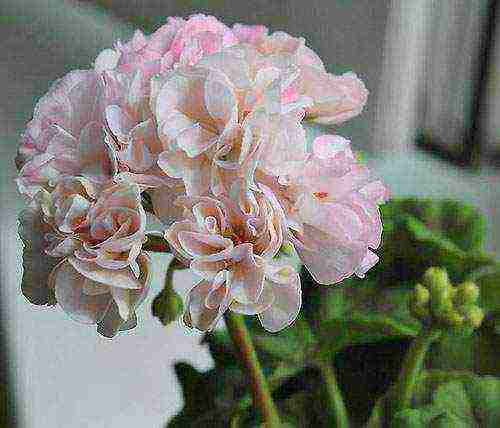 The bushes are compact, rather squat, the inflorescences are dense and, compared to the size of the plant, are voluminous.
The bushes are compact, rather squat, the inflorescences are dense and, compared to the size of the plant, are voluminous.
Pelargonium Elmsett
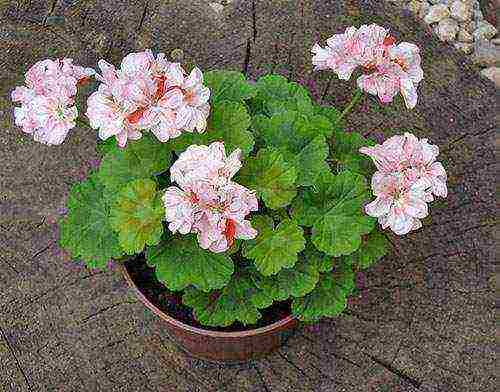 The incredibly beautiful Elmsett dwarf pelargonium belongs to the zonal variety. And the flower growers who see the plant fall in love with the bright leaves with a golden hue and double cream flowers, decorated with red spots and veins.
The incredibly beautiful Elmsett dwarf pelargonium belongs to the zonal variety. And the flower growers who see the plant fall in love with the bright leaves with a golden hue and double cream flowers, decorated with red spots and veins.
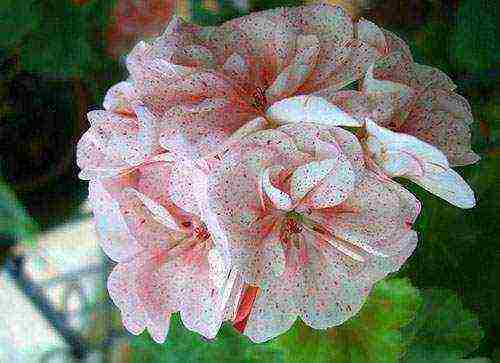 The color of the bush is long and abundant, its shape is very neat, so the plant will easily decorate any windowsill.
The color of the bush is long and abundant, its shape is very neat, so the plant will easily decorate any windowsill.
Pelargonium Lara Harmony
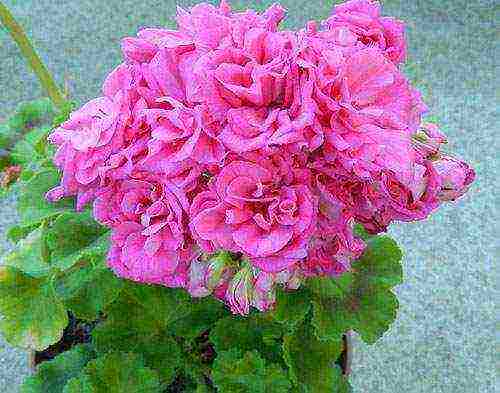 The flowers of the zoned pelargonium Lara Harmony, when fully opened, are incredibly similar to real roses, however, the variety is terry. The size of the bush is standard, the leaves are of a classic color for the species, the flowers are densely double, lush, with a spectacular pink color, which is somewhat weaker in the lower part of the corolla.
The flowers of the zoned pelargonium Lara Harmony, when fully opened, are incredibly similar to real roses, however, the variety is terry. The size of the bush is standard, the leaves are of a classic color for the species, the flowers are densely double, lush, with a spectacular pink color, which is somewhat weaker in the lower part of the corolla.
Pelargonium Norrland
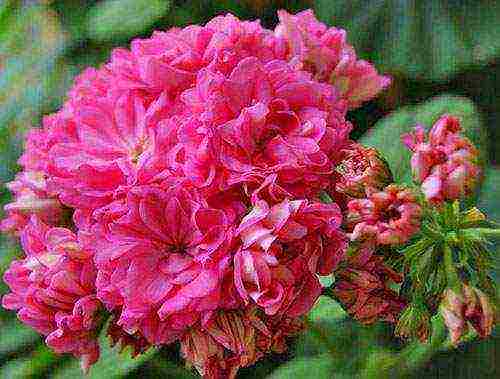 This variety of pelargonium, as in the photo, can be distinguished by strong shoots, rich green foliage, characteristic of plants of the zonal variety, and double peony flowers. Thanks to the lush inflorescences of Pelargonium Norrland is well known to lovers of this culture and has earned the sincere love of flower growers.
This variety of pelargonium, as in the photo, can be distinguished by strong shoots, rich green foliage, characteristic of plants of the zonal variety, and double peony flowers. Thanks to the lush inflorescences of Pelargonium Norrland is well known to lovers of this culture and has earned the sincere love of flower growers.
 To achieve high-quality flowering, the plant needs proper care, pruning and attention. And in this case, the bushes will certainly delight with pink densely double inflorescences.
To achieve high-quality flowering, the plant needs proper care, pruning and attention. And in this case, the bushes will certainly delight with pink densely double inflorescences.
Pelargonium Passat
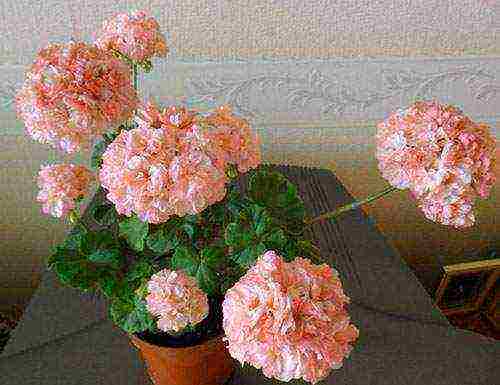 Very decorative double flowers of Pelargonium Passat amaze with a light pink shade of corrugated petals and density, reminiscent of delicate fluffy pom-poms. The variety has long been known to lovers of pelargoniums and enjoys well-deserved attention from both beginners and long-time adherents of culture.
Very decorative double flowers of Pelargonium Passat amaze with a light pink shade of corrugated petals and density, reminiscent of delicate fluffy pom-poms. The variety has long been known to lovers of pelargoniums and enjoys well-deserved attention from both beginners and long-time adherents of culture.
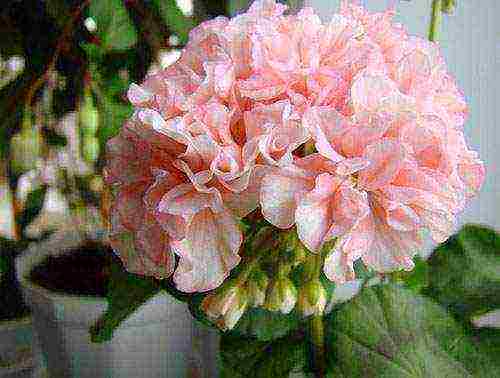 The bushes of this zonal pelargonium need shaping, but with good care they bloom for a long time and with high quality.
The bushes of this zonal pelargonium need shaping, but with good care they bloom for a long time and with high quality.
Pelargonium Granny Barter
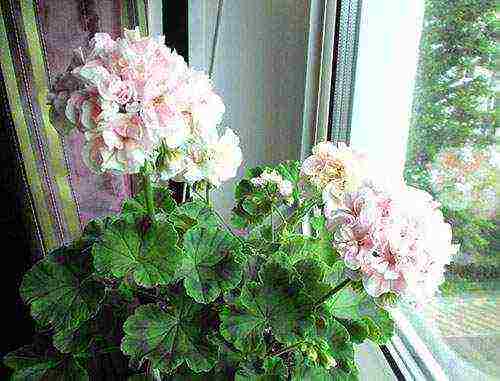 Pelargonium flowers Granny Barter are similar in shape to the formal bows of schoolgirls, their petals are so light and delicate.
Pelargonium flowers Granny Barter are similar in shape to the formal bows of schoolgirls, their petals are so light and delicate.
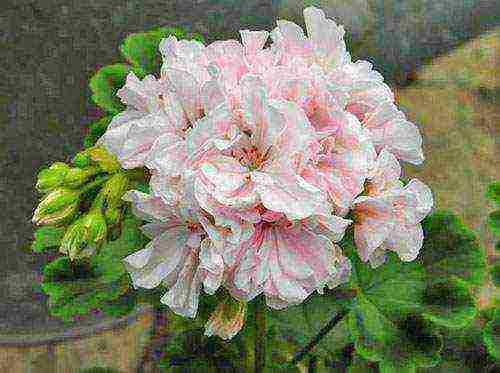 Densely double corollas of white-pink color form dense inflorescences that look great on bushes of standard height. The variety has established itself as trouble-free and very flexible.
Densely double corollas of white-pink color form dense inflorescences that look great on bushes of standard height. The variety has established itself as trouble-free and very flexible.
Pelargonium Ainsdale Duke
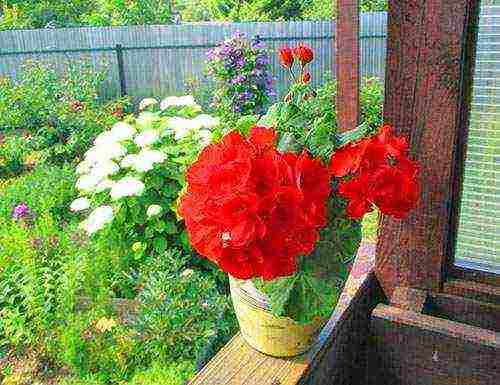 Strong, powerful shrubs of this variety of pelargonium are covered with dense foliage and luxurious inflorescences consisting of deep red double flowers. A dark stripe on the outside of the leaf plate adds decorativeness to the leaves.
Strong, powerful shrubs of this variety of pelargonium are covered with dense foliage and luxurious inflorescences consisting of deep red double flowers. A dark stripe on the outside of the leaf plate adds decorativeness to the leaves.
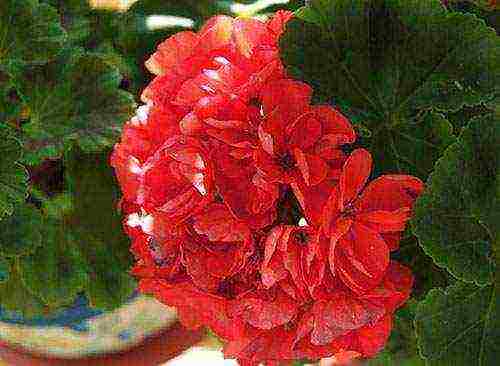 Pelargonium Ainsdale Duke is very solemn and effective. Many other plants fade next to it, which must be taken into account when selecting collections of varieties.
Pelargonium Ainsdale Duke is very solemn and effective. Many other plants fade next to it, which must be taken into account when selecting collections of varieties.
Pelargonium Bold Ann
 The delicate pink, very attractive Bold Ann pelargonium flowers invariably attract the attention of growers to this terry variety of the zonal variety.
The delicate pink, very attractive Bold Ann pelargonium flowers invariably attract the attention of growers to this terry variety of the zonal variety.
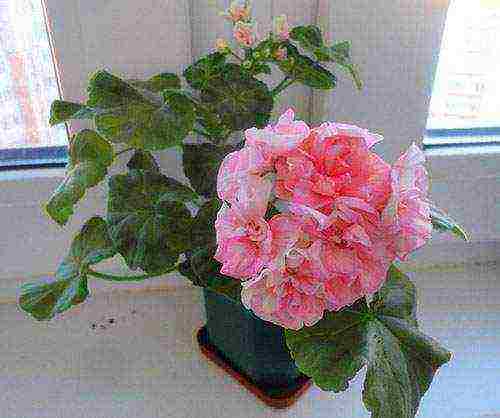 Pelargonium bushes are neat, inflorescences do not lose their beauty for a long time, and the plant is undemanding and willingly responds with flowering to easy care.
Pelargonium bushes are neat, inflorescences do not lose their beauty for a long time, and the plant is undemanding and willingly responds with flowering to easy care.
Pelargonium Bold Pixie
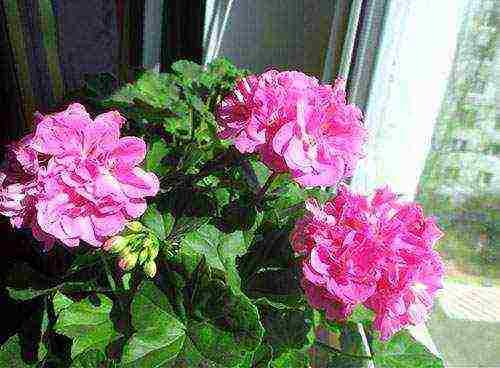 Zonal dwarf pelargonium Bold Pixie will surely delight flower growers who love double flowers of a raspberry-pink shade, which is unusual for this culture.
Zonal dwarf pelargonium Bold Pixie will surely delight flower growers who love double flowers of a raspberry-pink shade, which is unusual for this culture.
 On small bushes, bright inflorescences look doubly advantageous, and, in addition, a significant advantage of the variety is the almost independent formation of the bush.
On small bushes, bright inflorescences look doubly advantageous, and, in addition, a significant advantage of the variety is the almost independent formation of the bush.
Dovepoint Terry Pelargonium Video
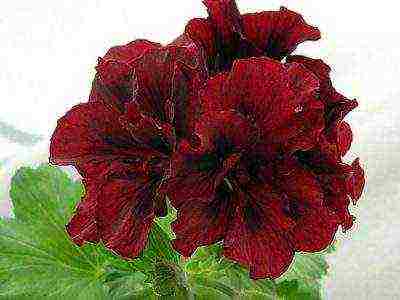 Pelargonium is an amazing houseplant. After all, this flower has many varieties, among which the most famous are the royal and zonal species.
Pelargonium is an amazing houseplant. After all, this flower has many varieties, among which the most famous are the royal and zonal species.
Almost all year round, they delight flower growers with their colorful inflorescences. They are used to decorate balconies, terraces and plant on personal plots.
In addition to being bright and compact, they have a number of other advantages. This is the reason for its growing popularity from year to year.
So, let's take a closer look at what kind of plant it is and how to grow it at home.
…
What is this flower?
Pelargonium is a herbaceous semi-shrub flower. There are already more than 400 varietal varieties around the world. The name comes from the shape of the fruit, which was similar to a crane's beak. The first species were identified in Africa. A pleasant smell and neatness have been loved since ancient times, and after that they began to appear in every home. Popularity has appeared due to active growth and unpretentious care. In warm circles, the plant lives in the garden, as the height can reach large sizes.
Important! Do not leave the plant in the shade. When purchasing a flower, select a sunny and warm place for it in advance.
Species names with descriptions and photos
There are a huge number of varieties in pelargonium and the classification of some species is still uncertain. Let's move on to the most famous plants that can be found in every person in the house.
Orange
Orange pelargonium grows up to 35 cm in height. Extraordinary look with a peach cap on each bud and a greenish tint around the edge. With good care for 4 seasons, it changes 240 inflorescences. Provides a pleasant view of the balcony. Does not require increased attention to itself. Prefers semi-shaded areas. Watering should be abundant, a little less in winter. In summer, it is best to take it out into the fresh air. You can plant seeds in any weather.
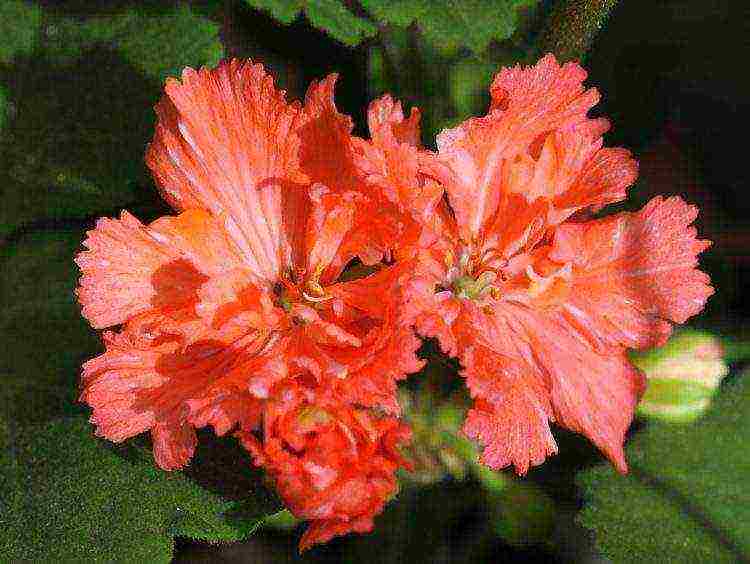
Ice rose
Ivy-leaved pelargonium is white. The foliage is medium in size, dark green in color. Compact plant. It does not grow quickly, but the buds of this variety are worth it. The flowers grow in large sizes up to 6 cm, the shape is folded in the form of a rose. If you hold the plant in the sun for a bit, you can achieve a slight lilac hue.
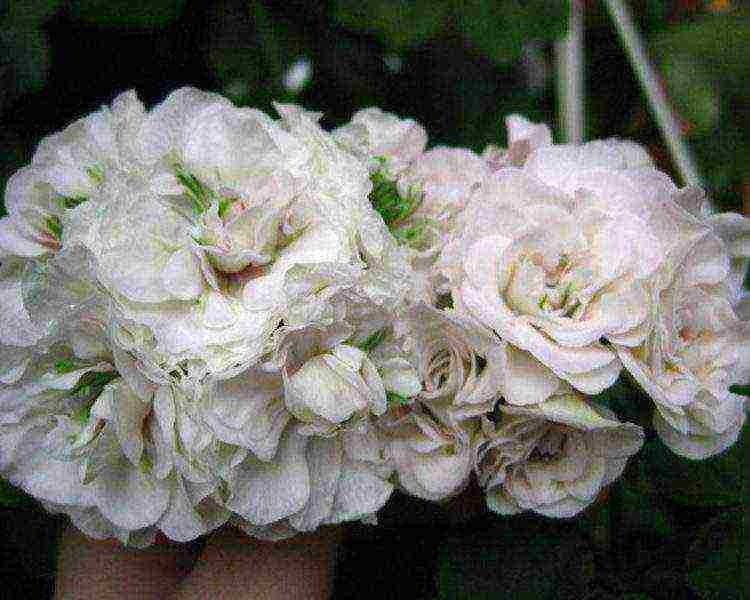
Unique
It differs from all the others, because even the origin of this plant is still unclear. The species is not included in any classification, which is why it is named unique. Its foliage belongs to dissected leaves. The aroma is spicy, without too much harshness. The small flowers are similar to the feather of a bird. Plants can have one or two-colored foliage. The variety is tall. The peak of popularity of the unique took place at the end of the 19th century.
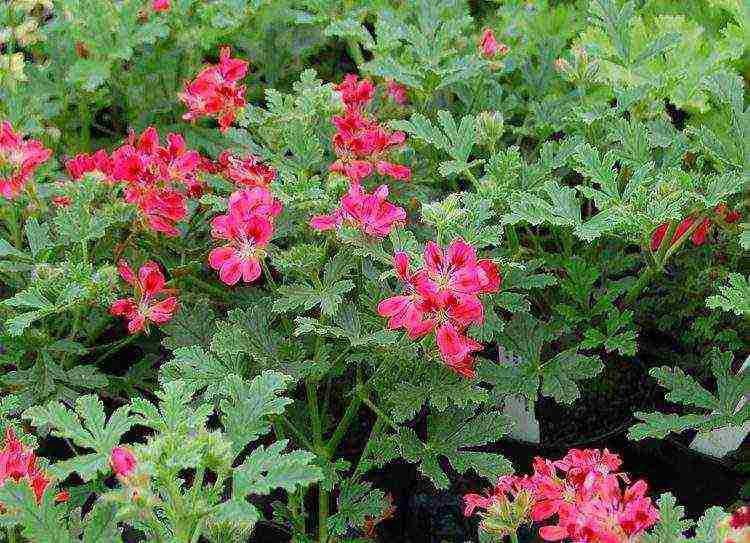
Irida confetti
Refers to zonal pelargonium. Their flowers are whitish with a pinkish tint in the middle. Small foliage. In a pot it looks impressive and without unnecessary flaws. It takes on a brighter tone in the sun. And in winter it requires special care and feeding.
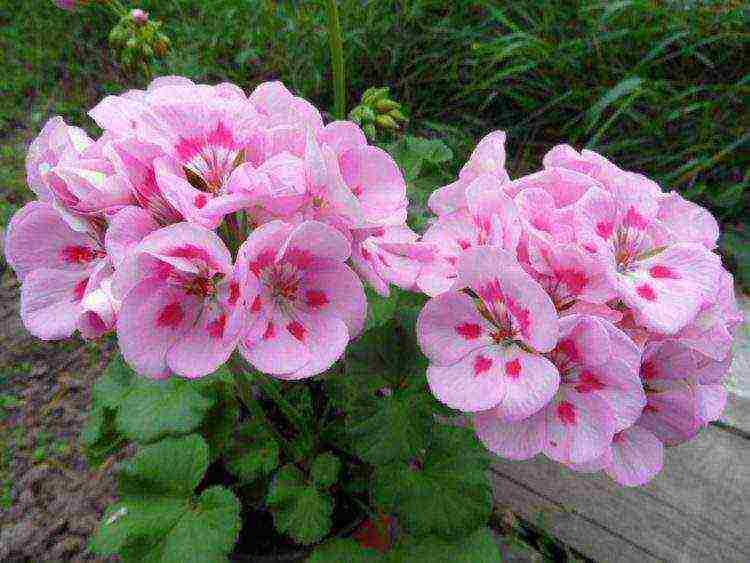
Mini diana
Miniature golden-leaved pelargonium. Belongs to the zonal group. Despite the small size, the flowers are large, white-pink in color, on which there is a pleasant golden tint. The leaves are semi-double with a light green tint. Each leaf has a bright brown area. Blooms at an accelerated rate. Not whimsical. In a small pot, the flower looks compact and fluffy.
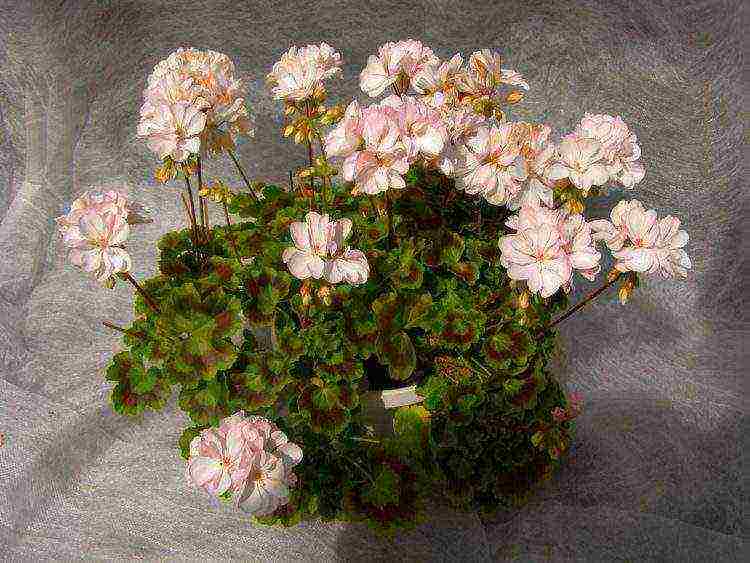
Diana Palmer
Zonal pelargonium. The petals are wavy with serrated edges in the shape of a carnation. Light shading. A spectacular bush, not whimsical in bloom. Has a pastel orange tone. In order for a flower to sprout, it needs pruning. It bushes well, looks large and grows. Leaves are compact. Inflorescences grow up to 5 cm. Quite a well-known variety. Mostly good flowering occurs in the summer. This plant needs feeding.

Natalie
Small semi-double species pelargonium. The first flowers give a size of 4 cm. Grows in large caps. The bush is graceful, compact, but rather moody. Not very tall. After pruning, the sprouts do not give immediately, most often only replaces. Reacts to temperature changes.The variety is gentle. It has a peach color with a pale white edging of petals. The trunk is almost always non-leafy. Formation does not occur immediately. In hot weather, it can throw foliage. The plant is noteworthy for its dissimilarity.

Powder poof
Small zoned pelargonium with salmon color. The lining of the petals is light, and the leaves themselves have a dark zone. A neat fluffy bush. The heat makes the cap turn white and thick, which gives a pleasant contrast. Shoots form quickly. Bright and pleasant to look at. Many buds are almost always present. The plant itself is small, which is why it will look perfect on the windowsill. Spraying is helpful. Take out to the balcony only in hot weather. Dwarf variety.

Bornholm
Dense double flower in the form of an unopened rosebud. The petals of this plant are deep red. Each rose is 1 cm. In hot weather, the red color becomes a little paler, and in winter, on the contrary, it acquires a bright shade. The inflorescence is dense. Peduncles of medium height. Green sheets with a cream-colored mosaic pattern. Treat the type of zonal. It blooms in the shape of a cap. Grows to medium size over time.
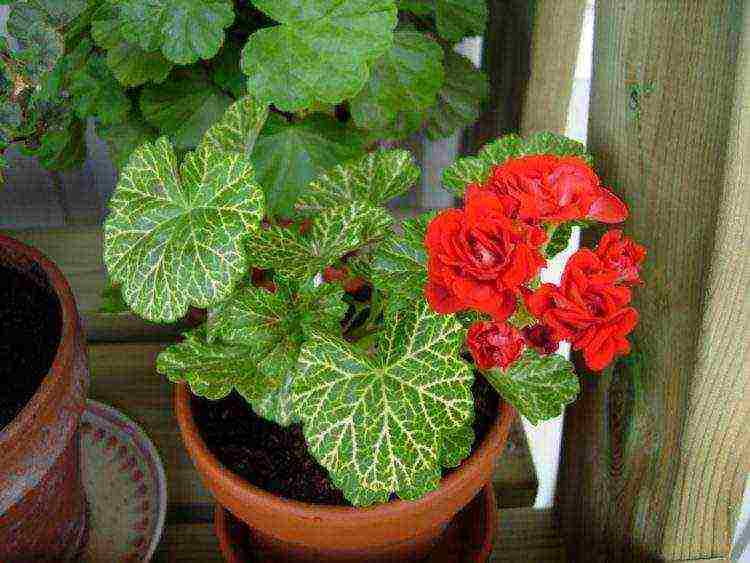
Albina
Pelargonium Albina grows rather quickly. After the emerging cutting, the peduncle rises for 3 days. However, the first bloom is not particularly abundant. 4 flowers grow on 1 peduncle. Large plant. Treat zonal, in terms of growth is considered a dwarf. Leaves are intensely green. The flowers themselves are double, white with a small red stamen, collected tightly. Due to the density of this species, the plant looks collected and neat. He loves feeding, therefore, thanks to courtship, the flowers become larger. Suitable for beginners who take responsibility.
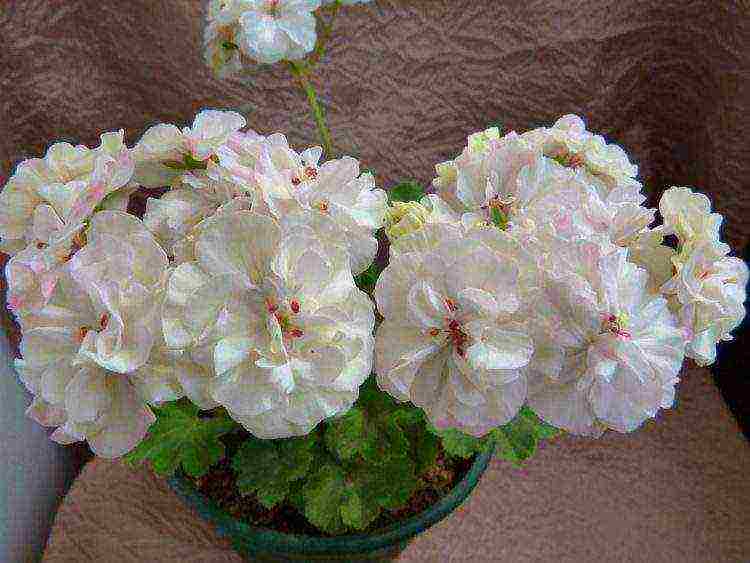
Elmset
Zonal variety of dwarf speckled pelargonium. Florists are attracted by bright, golden-green leaves with creamy double flowers and red veins. The flower is decorated with light bright crimson specks. Long lasting. With a neat shape, it blooms profusely. The bush is plump and strong. Does not throw leaves, bush itself.

Dovepoint
A neat decorative border and a barely noticeable pink color, which echoes with white, distinguish this plant variety from other terry types. The inflorescences are dense and delicate, compared to the dwarf type, voluminous. In the sun, the blossoming of the dovepoint turns from white to pink. Peduncles are short.
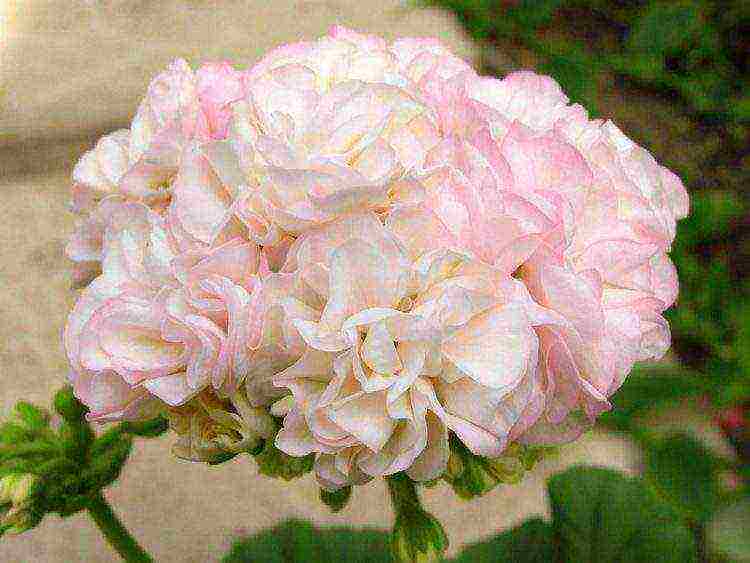
Crown Princess Mary
Mary belongs to the terry zonal pelargoniums. The inflorescences are tight, reminiscent of a rose. They grow up to 10 cm. The flowers themselves are white with a slight green in the center. When blooming, it may acquire a slight pinkish tint. The bush is fluffy. It blooms profusely in spring and summer. It should be replanted annually. Loves the sun and warmth. Tries to bloom even in low light. Prefers a complex top dressing. The name of this variety goes well with the name.
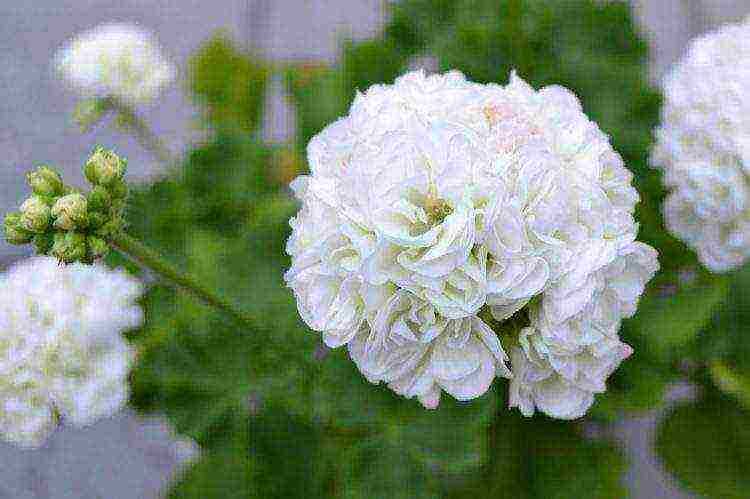
Princess Sandra
Terry pelargonium belongs to the zonal type. The flower is light red with a white section in the center. According to the type of growth, it is considered standard pelargonium, which means that it can grow quite large.
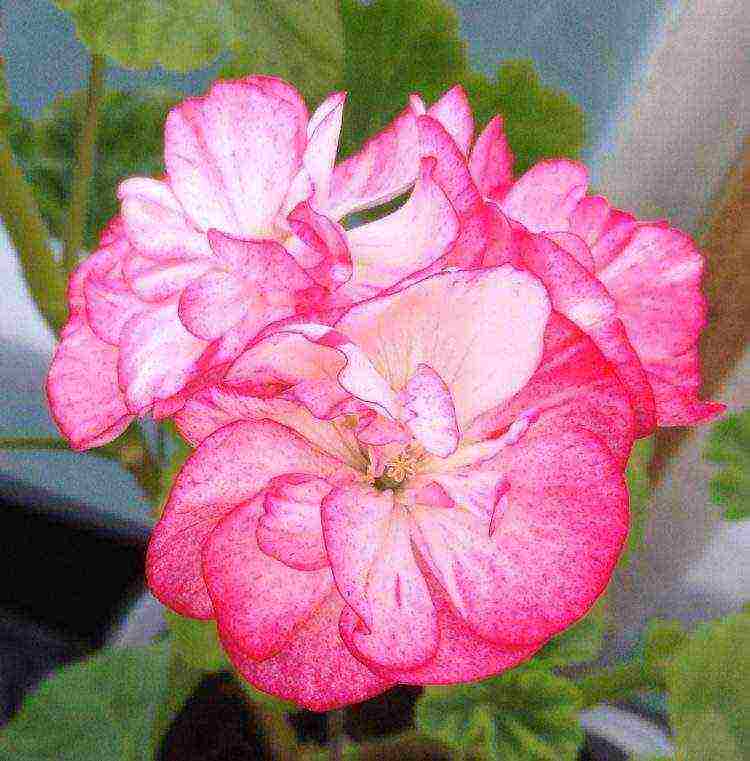
Passat
The double flower of the trade wind strikes with a light pinkish shade of corrugated petals. The density of this variety resembles a delicate fluffy pompom. The species is known among lovers of pelargoniums and beginners. Bushes need help in shaping, but with good care they bloom efficiently and abundantly. A sunny variety that will warm you even in cloudy weather. You can also see how this varietal flower looks in the photo.
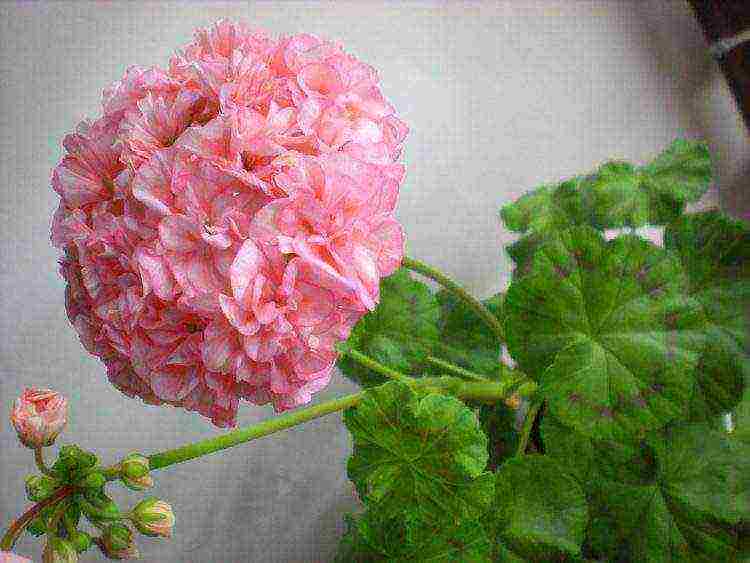
Peppermint Twist
Terry pelargonium. Large flowers with a peach-pinkish color, densely covered with cherry specks. The leaves are green with a brown zone in the center of the leaf. They retain their decorative appearance for a long time. Standard bush, blooms profusely. A bright variety for lovers of variegated plants.
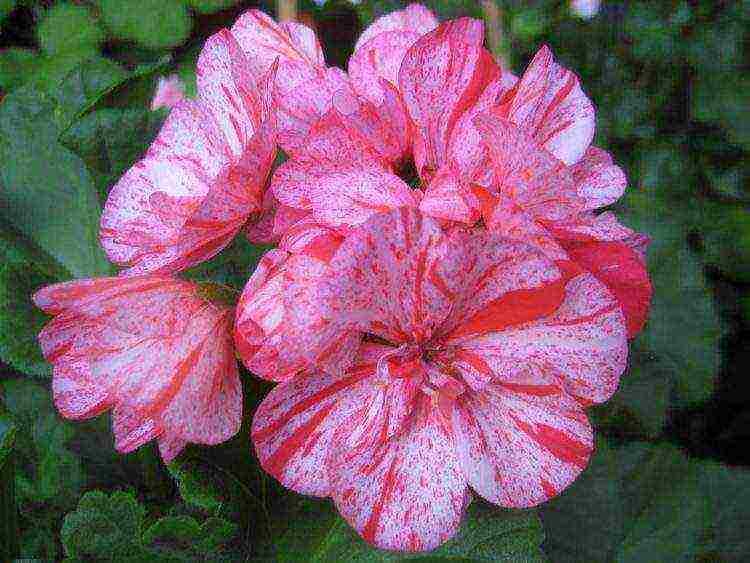
Varnish
The wavy petals of pelargonium varnish are colored orange, and towards the edge of the flower they become completely white. The distinctly colored color can only be seen in the sun. In the shade, the brilliance fades. The plant belongs to the usual zonal variety, but in addition it requires careful formation. The leaves are elegant, thanks to the contrasting border of a brownish-green hue.
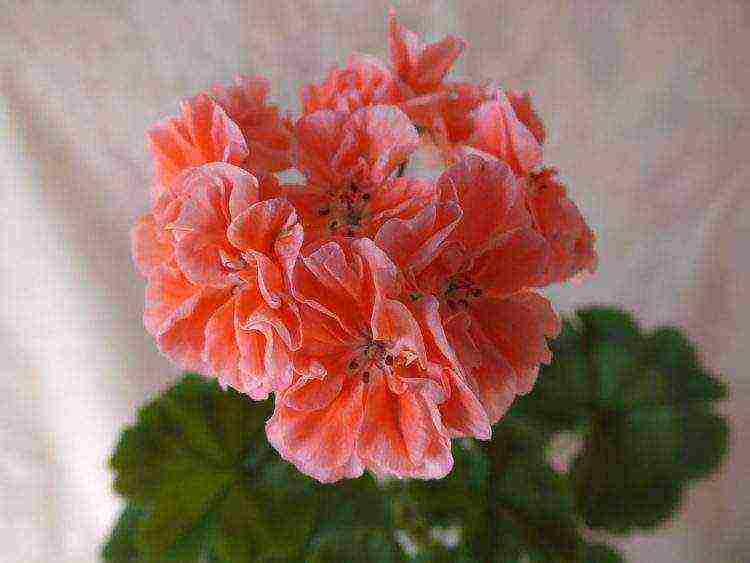
Bronze butterfly
There is a light butterfly-shaped shade in the center of the leaf., which, basking in the sun, can give a bronze tint. The flower itself is large with a peach color and needle-like shape. The variety is not tall, the peduncles are short. Requires shaping. It bushes and blooms for a long time. He is not afraid of rain and heat. Looks great on the balcony in summer. The size can be easily adjusted using a small flowerpot. Unpretentious, fast-growing. It is the unusual leaves that make this species special.
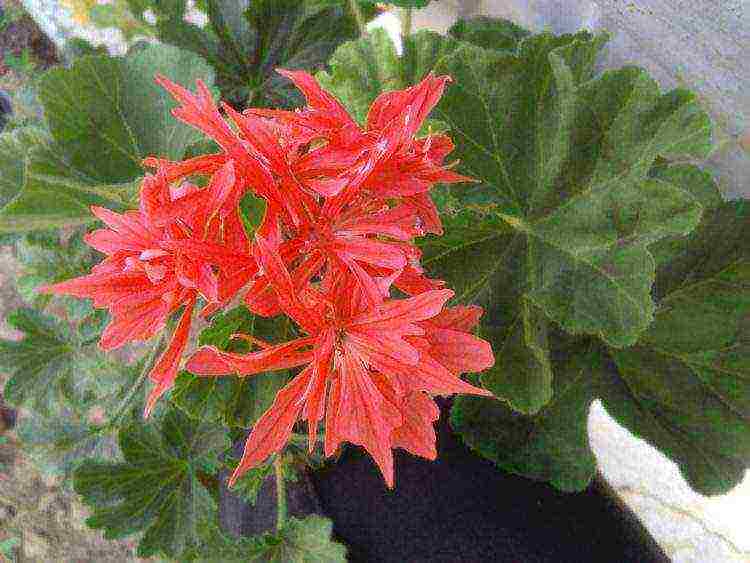
Magnus
Plant of terry zonal pelargonium. Flowers in the form of a red rose shade. The flower itself is bright and velvety. It blooms profusely, looks compact. The hat is round. The leaves are green, shimmer with a slight brown tint. Live it has a very bright colorful color.
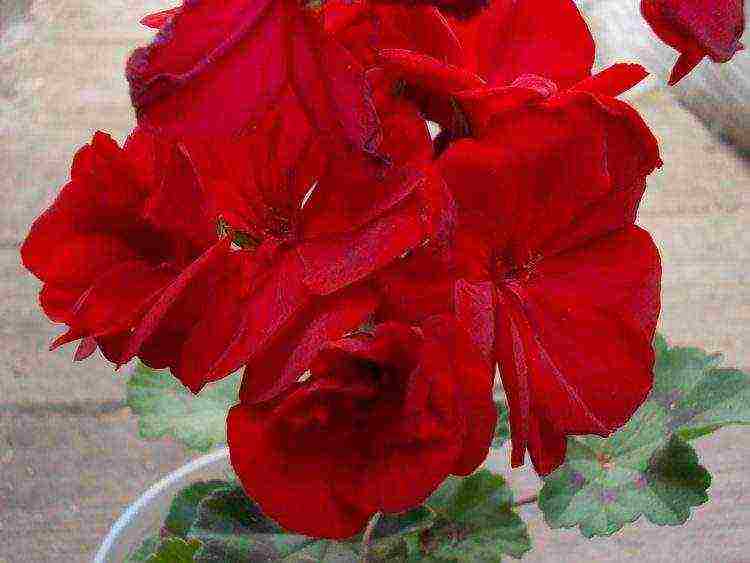
Tsarskaya
In summer, you can see this type of plant in gardens, flower beds and balconies. Differs in lush flowering and grace. Demanding enough to care. Blooms for a short time, about 5 months. But if you see this plant at least once, you will immediately want to bring it to your windowsill. Tsar Pelargonium grows up to 60 cm in height.
It differs from its colleagues in folded multicolored leaves, dense platinum sheet and jagged edges.
On a note. Not everyone succeeds in making such a beauty bloom. This particular person prefers warmth and sunlight for continuous profuse flowering.
It can put up with a small shadow, but it will bloom a little less luxuriantly. The soil prefers nutritious. You can add a little clay mixture to the soil. In cold weather, the temperature should be at least 12 ° C.
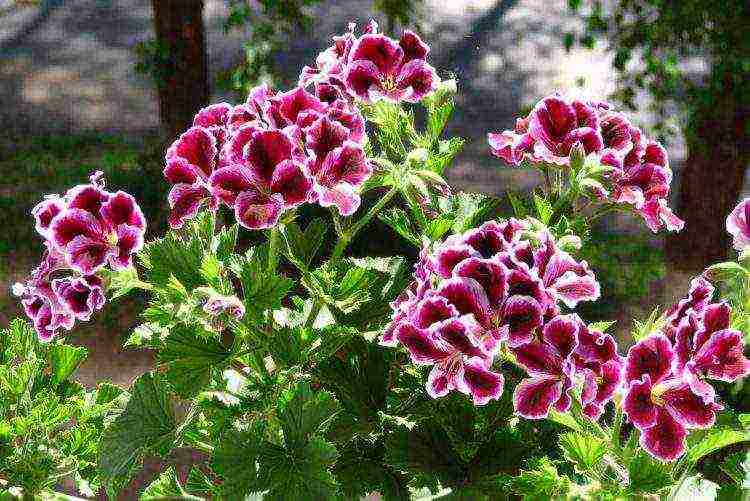
Tamara
Tamara is many-sided and unique. Flowers are like dense pink and white marshmallows. The color is changeable with pink veins and a border of the same color. The plant is gentle and airy. A compact bush with small leaves. It blooms from infancy and never ceases to delight with the process. The petals are neat, with pointed tips.
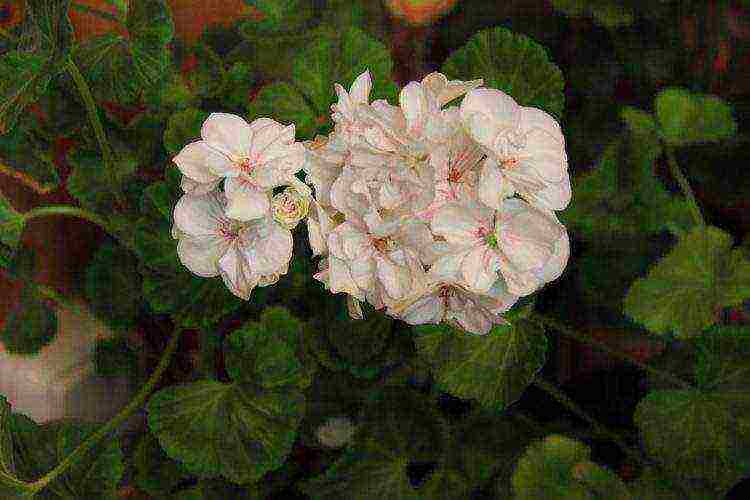
Red
Sunny side required. The soil should be moist at all times, but in moderation. It is recommended to spray. Red pelargonium grows up to 30 cm in length. It should be placed on the balcony immediately after the frost has passed.
Possesses a bright shade and universal resistance to all weather conditions. The variety branches well. There are huge inflorescences. The color of this type of pelargonium is similar to wine red. The leaves are ivy. Growing fast. Landing 30 × 30.
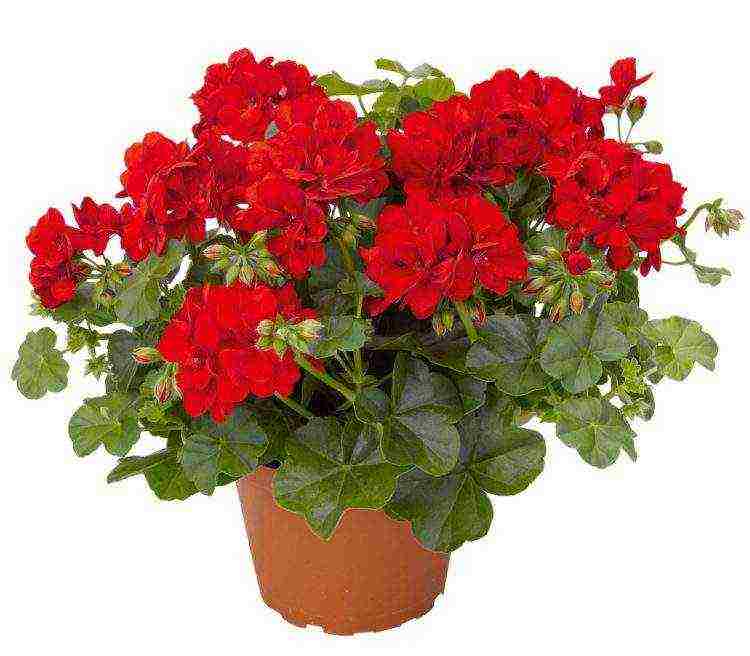
Maverick white-pink
The plant is 30 cm tall with good branching. The color is white-pink. The inflorescences are large. The leaves are green with a slight dark tinge. Drought-resistant. Preference is given to sunny places with fertile soil. You can start planting from the end of January. The seed depth is 0.5 cm. If the temperature is kept to 20 ° C, then the seedlings can be seen in a week.
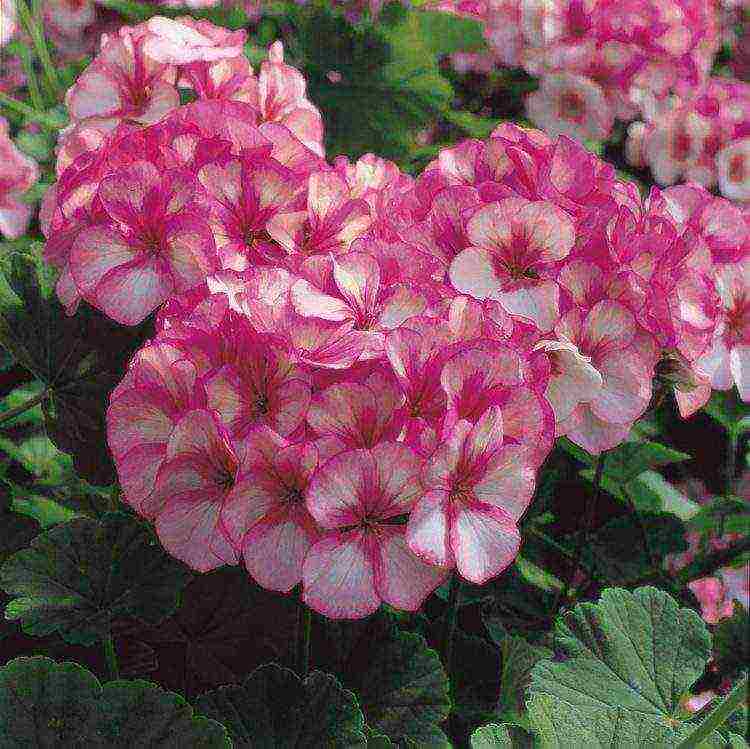
Tuscany
Pelargonium belongs to non-double, ivy. Large caps and beautifully colored color in various shades. Blooms profusely, completely covered with inflorescences. Currently, there are two popular types of Tuscany.
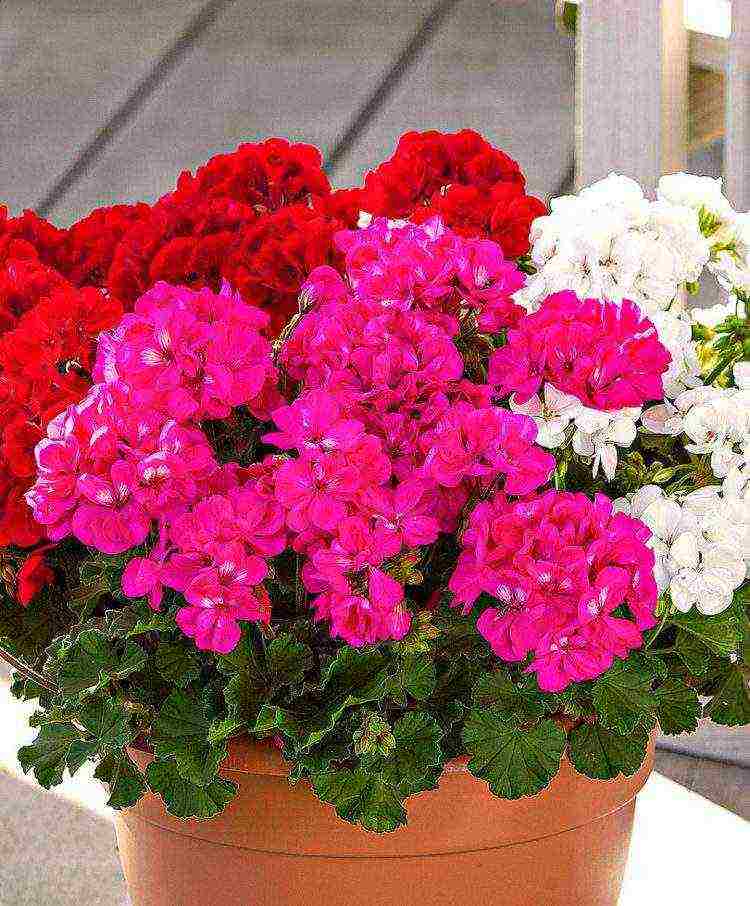
Bernd
Bright flowers, wide opening, deep red color. Each leaf is dark green in color with a bright brown ring. Treat semi-double. The bush is harmonious, it never stretches. The lower part of the flower must be tamped tightly.
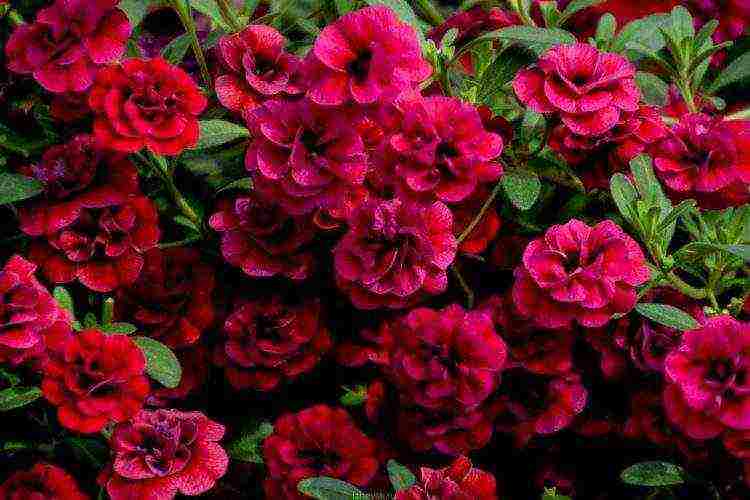
Hero
Large crimson-red flowers with white dots on the leaves. The bush is fluffy. It grows slowly, but very good branching. The leaves are medium-sized, colored dark green. The bush is not tall, the average height is up to 25 cm. The color is very rich. Does not require growth regulators.
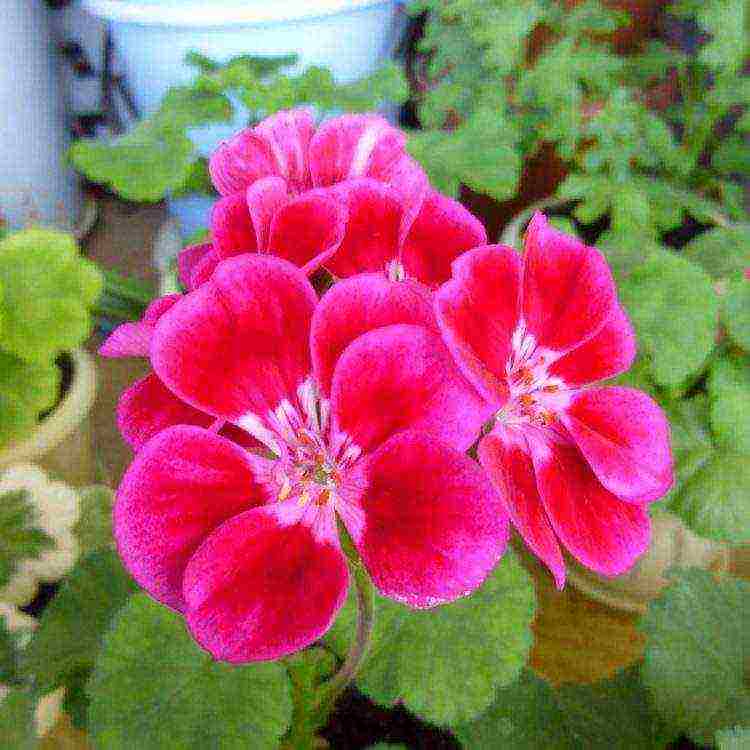
Apple blossom
A herbaceous plant with a fragrant aroma. The height of the bush is 25 cm. The leaves are rounded, green with a small red edging. The flowers are pink in color with a slight pallor in the form of a spherical inflorescence. The plant prefers light. For feeding, choose a sod mixture, and prefer moderate moisture. If the flower is treated with love, then flowering will continue all summer. In the fall, a transplant and a bright place in the room are needed. For seed germination, the temperature must reach 20 ° C.
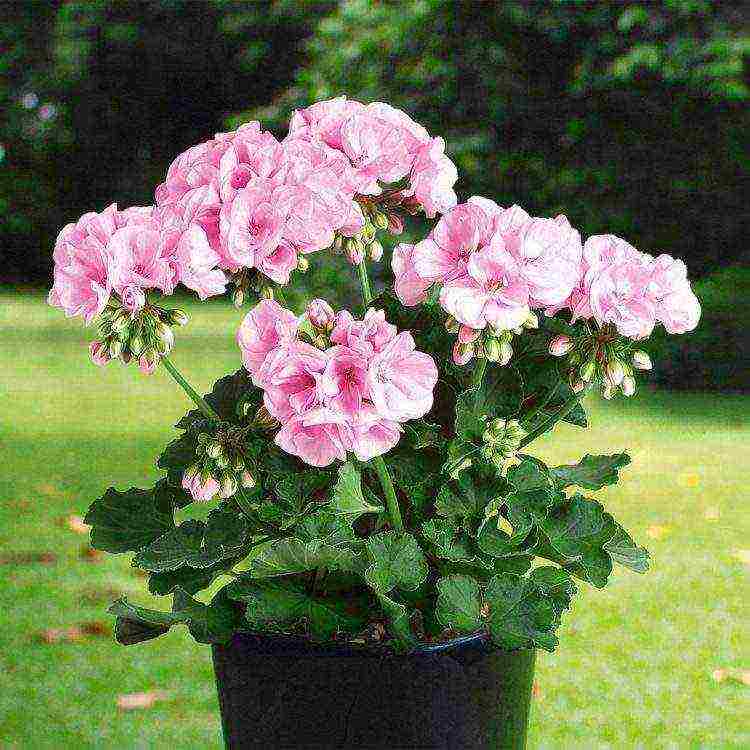
Black velvet
The difference between black velvet is in unusual chocolate sheets, which create an excellent combination with bright red inflorescences. If the bush is formed recently, then you can notice that at the initial stage there is a bronze dusting on the sheets. The height of black velvet reaches about 40 cm. The shoots are strong. Loves light, but the sun's rays should not touch the petals.
Pelargonium is unpretentious, but this does not mean that she does not need care. You need to check the soil periodically and water it on time. Prefers mineral fertilizers. Sowing 1 cm. It is not recommended to allow the soil to dry out.
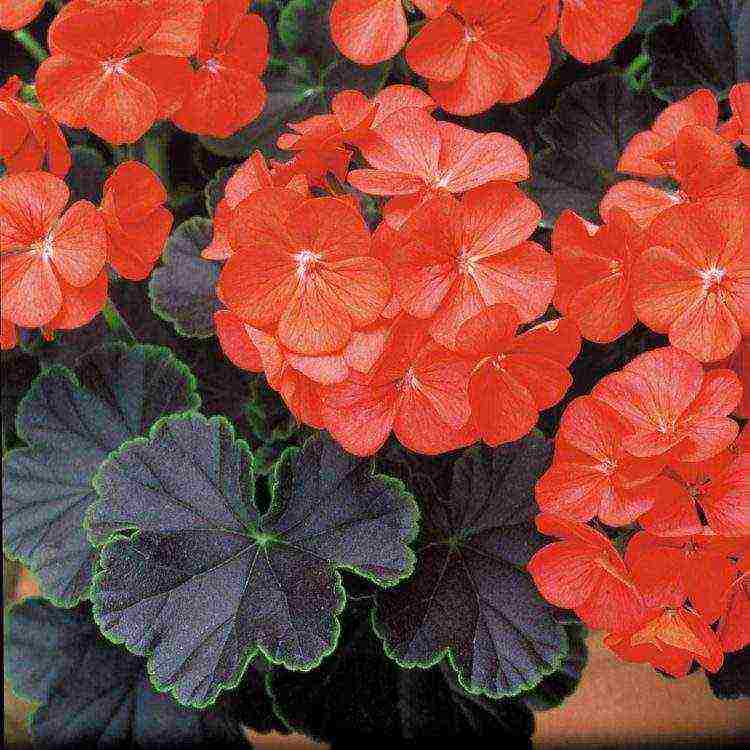
Indoor hybrids
The hybrid variety grows well at home. It looks like a large shrub up to 75 cm in height. Rounded green leaves. Umbrella-shaped flowers up to 3 cm, there are multi-colored shades, namely: white, pink, red, purple. Flowering lasts six months.
The most popular Pelargonium hybrids are two.
Ardens
A rare hybrid plant. A flower with the color of wine red, with a black stripe in the middle. This hybrid plant is easy to care for, but demanding on light. Moderate watering is required. An adult plant reaches a height of 20 cm.
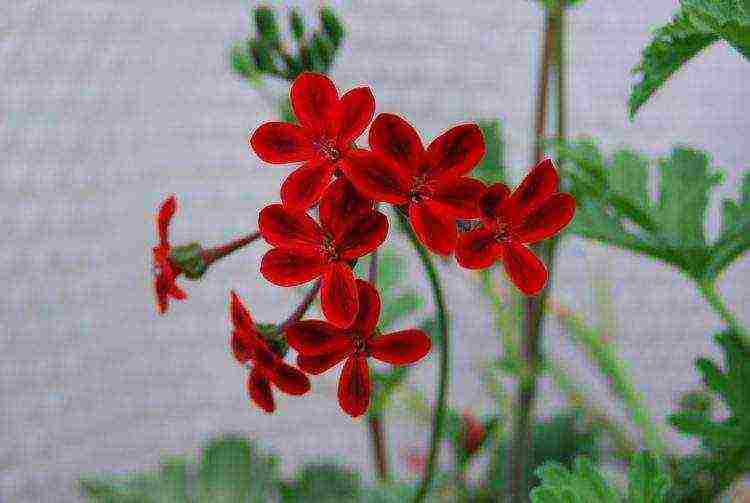
Miss Stapleton
The plant never sleeps. This heart-shaped hybrid looks like a bouquet of pink roses. Stems are firm with stipules in the form of thorns.

Scarlet
Rosaceous pelargonium. Flowers are dense, double. The petals are of two colors. The inside looks like red wine and the inside is silvery. The inflorescences are dense. Leaves are greenish, folded.
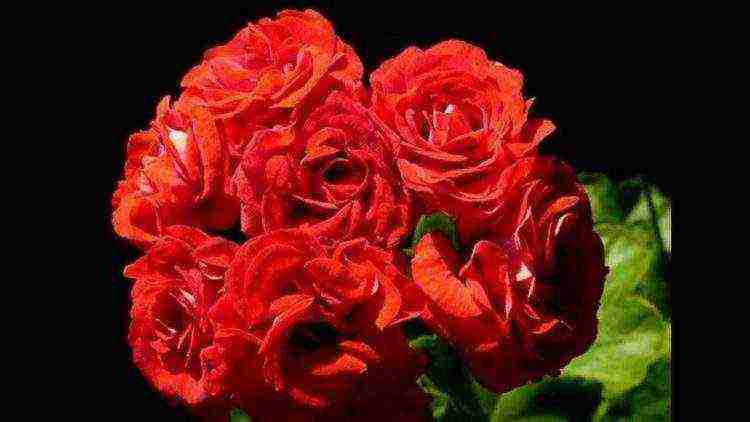
Madam
Madame Pelargonium has several varieties. Let's consider the main ones.
Bovary
Type of terry zonal pelargonium. Fluffy bush. Blooms profusely. The flowers are like dark red wine, there are bright and large inflorescences. Keep the soil moist and spray as often as possible.
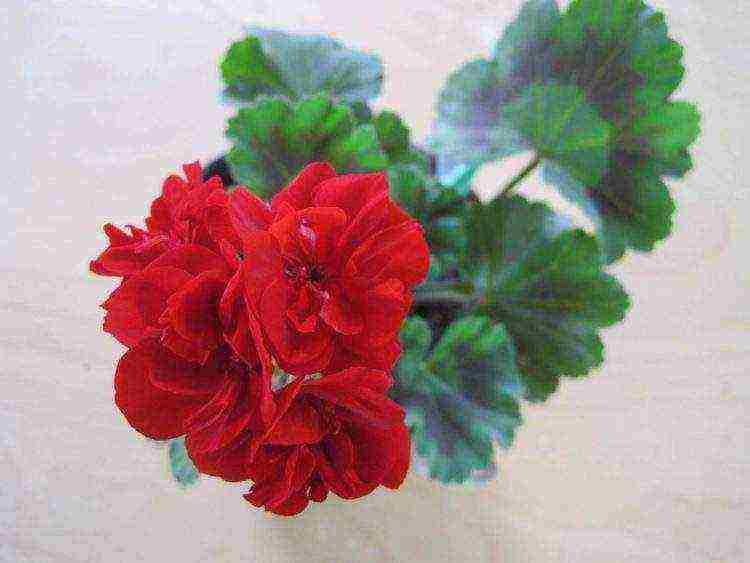
Seleron
Graceful pelargonium with variegated leaves. Leaves with long stalks, gray-green with a wide creamy edging. Has thin cuttings. Treat a dwarf group. It blooms in a bright pinkish color. The variety almost does not bloom, but captivates with its beauty. The bush is compact and pleasant to look at.
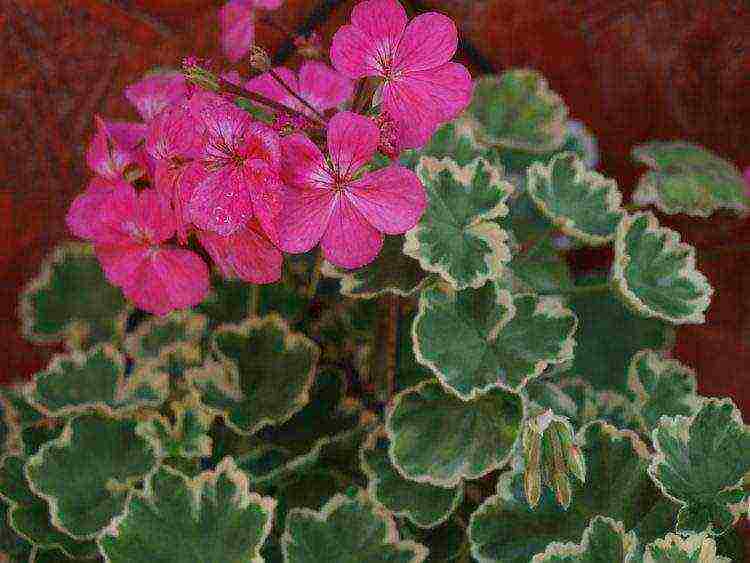
Fisher Apleblossom
Large flowers resembling a rose. The plant is white, with a rich white-pink border. Tight hats. The bush needs shaping. The leaves are green and have a dark area. Requires special care.
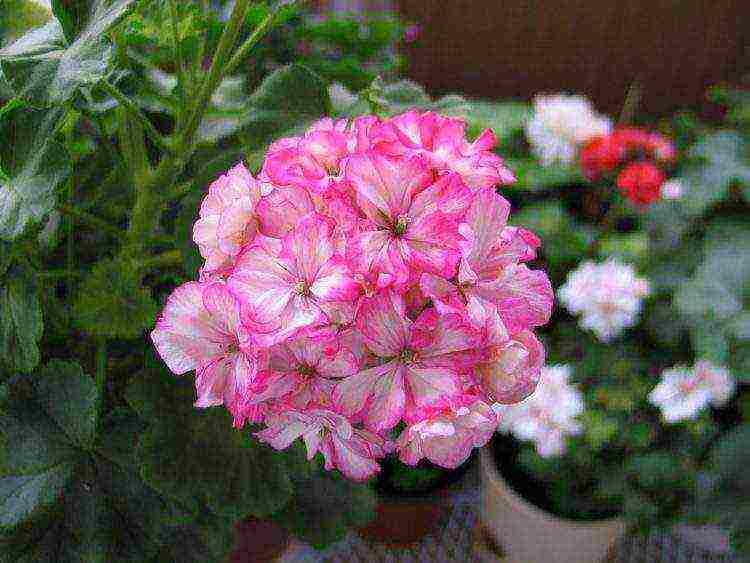
Blue
Terry ivy pelargonium. The flowers are similar to a blue-lilac shade. Compact bush. Needs a sunny area. Requires daily care. The plant needs additional minerals.
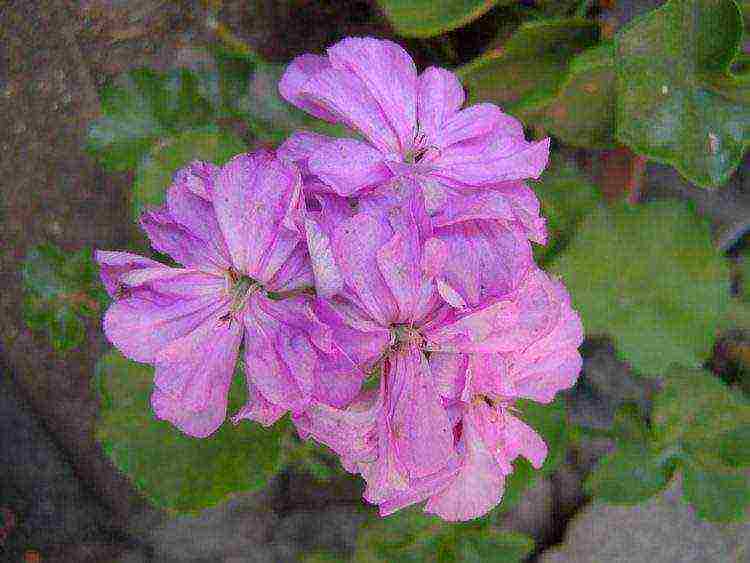
Miniature varieties
For the first time, miniature pelargoniums appeared in England. The height of small pelargonium starts at 8 cm and ends at 15 cm. Ideal for home use, they can also be placed on balcony boxes. Leaves come in multi-colored green hues. Pelargoniums are light and airy, but this is not their only advantage. They are compact. They can bloom in any decade.
Small plant species are currently classified into groups:
- Zonal.
- Ivy.
- Royal.
- Variegated.
- Succulent.
- Fragrant.
Most of the plants belong to the zonal species. The name was derived from the small areas on each sheet. Usually these are areas of dark brown color, which are located in the center. It was thanks to breeders from England that small varieties of pelargoniums appeared.
Reference. Do not leave pelargonium varieties in cold places. Most species need a standard temperature of 15 ° C.
Stanley Stringer is among the most worthy breeders. He was born in a small village called Okkold. He started breeding at the age of 50. The most popular cultivated cultivar remains Alde, which can be seen on the shelves today. Diverse
Deacons are also stringer dwarf varieties. Among them, the best are: tangerine and moonlight. The flowers in the mandarin are orange-red, and in the moonlight they are white and purple. The most impressive thing is that such a miniature plant has very large flowers.
One of his last cultivations, is a golden goblet that had a creamy hue, and the petals were strewn with red dots. Stringer left behind about 160 varieties of pelargonium.
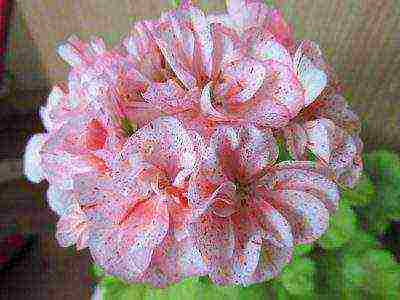 Paradise Bitwell began life as a postman. Therefore, it has a number of geographical variety names. Beatwell became famous for the fact that he managed to bring a new kind of polka dot variety. And they were covered with red, pink and purple specks.
Paradise Bitwell began life as a postman. Therefore, it has a number of geographical variety names. Beatwell became famous for the fact that he managed to bring a new kind of polka dot variety. And they were covered with red, pink and purple specks.
Among the varieties with small spots, the most popular are Milden, Semer and Elmsett. Milden has green-yellow leaves with bright white flowers covered with pale pinkish specks. Semer is a dwarf species of pink flowers with red dots. Elmsett is a zoned look of pale pink flowers with red dots. The latter species was named after Bidwell. The variety is decorated in a wine color with green-red foliage.
And last but not least, the famous breeder Brian West. West is known for breeding a variety with leaves that resemble stars, which is why the variety is called star-shaped. The varieties have spread all over the world. Even despite the unusual shape and the fact that they do not quite resemble pelargoniums, you can take care of them in the same way as for ordinary varieties.
In recent years, Vesta has given birth to miniature plants up to 8 cm. The varieties were named anni popham.
Care rules
Plants require special care and pelargonium is no exception. Usually the flower is in the room, and begins to bloom profusely in the summer. In winter, it is necessary to maintain a temperature of at least 15 ° C and avoid waterlogging of the soil. The plant is best left on the sunny side, but only where there are no drafts.
Pruning is carried out after flowering - in the fall. But if the roots have grown well, they make an exception. The transplant is recommended in February. For pruning, you need to leave shoots about 10 cm.Do not forget about feeding for each flower.
Plants can lose their compactness if not properly cared for.
On a note. It is best to get new specimens from cuttings that have not yet faded. Each stem should have about 5 leaves.
After pruning, the cuttings should be left in a dry room with fresh air for 2 hours. After pruning, cover them with plastic bags to help them take root. For the growth of pelargonium, a temperature of at least 20 ° C is needed.
Besides beauty, Pelargoniums also have medicinal qualities for humans. After all, they contain an extract that heals respiratory tract infections. In addition, the oil of this plant has a calming effect. But the main thing is that the flower goes well with any landscape in the house and allows every housewife to feel like a woman.
Among the most attractive garden and indoor plants, zonal pelargonium occupies a separate place. This flower is a frequent visitor to government agencies and parks.However, there are so many varieties of zonal pelargonium that you can always pick up a flower for your apartment.
Zone View History
Geranium of the genus Pelargonium zonal was first discovered in the middle of the last millennium on the African continent. The plant attracted the discoverers with its bright flowers and unusual shape of the capsule. This shape resembled the beak of a stork, which is why the new species was given the name Pelargoniums - derived from the Greek "πελαργός", which means "stork". And the word "zonal" appeared in the name due to the special color of the leaf plate - in spring and summer, a small zone appears on it, painted in a different color. Thus, the Latin name for the zonal geranium was formed - Zonal pelargoniums.
For the first time, zonal pelargonium came to the territory of Europe from Africa in the 18th century - it was brought by British sailors to their homeland. There the flower gained wide popularity and until the beginning of the twentieth century remained a symbol not only of the Victorian era, but also of the English bourgeois life in principle. At the time when the popularity of the plant in the British Isles began to fall, zonal geranium was already known throughout Eurasia, thanks to which its old varieties were actively bred and new ones were bred.
To date, more than 350 varieties of Zonal pelargoniums are known. The flower is grown both indoors and outdoors, and the variety of colors allows you to choose a crop option for every taste.
The best varieties
As already mentioned, zonal pelargonium has more than three hundred species. The most common are:
- Calliope Dark Red is a newly bred hybrid. The authors of this variety in the description must indicate the magnificent view of Calliope Dark Red - rich red double buds are located on a medium-sized shrub;
- another medium-sized variety Rafaella differs from Calliope Dark Red in larger inflorescences and a variety of shades - from pale pink to lilac;
- The Violet chandelier blooms with purple buds from May to October. This variety is suitable for both the street and the home, and with proper care, it will delight you with large inflorescences sitting on bright green stems;
- Pelargoniums of the PAC group (here we know as PAK) are more expensive hybrids. Most of them were bred in the last two decades. Varieties of PAK are distinguished by a wide variety of colors and shapes - flowers similar to roses and classic geraniums, white, blue and all shades of red. In our country, the most famous geranium hybrids under the following names are PAC Fireworks Red, PAC Fireworks Red-White, PAC Salmon Princess, PAC Viktor Improved , PAC Viva Carolina;
- incredibly beautiful hybrid Red Pandora belongs to tulip varieties. Inflorescences of Red Pandora resemble a set of small tulips of a delicate scarlet color. The variety blooms for a long time and does not require serious care;
- Pelargonium Montevideo grows into huge peony buds of a pale salmon color. The plant is medium-sized and suitable for growing in an apartment;
- Unicorn Zonartic Rose is a vigorous cross between the golden Lara Zonartic and the purple Lara Suzanne. The result is a plant with pale purple petals and large double leaves;
- another group of pelargoniums - Deacons. In this group, there are plants of various shades - platinum, orange, white, burgundy and others. The flowers are low, with sparse foliage. A number of varieties are bred in Italian Tuscany (Cato, Claudio, Eric, Bernd), other European countries are the homeland of others (Cupid, Emma Hawsley).
Features of growing and care
It is very easy to care for zonal pelargonium. All you need to do is choose the right planting spot and determine the correct watering schedule.
Home care is the most comfortable, since it does not require sheltering the plant for the winter and fighting rodents. However, there are also some nuances here. For example, if placing pelargonium on the street in spring and early summer is almost guaranteed to provide the plant with the required amount of light, then in the room you will have to find the brightest and most calm corner of the house - preferably a southeast window. If there is no such place, in winter the flower will have to be illuminated artificially - with the help of lamps.
Also, do not forget that sunburn has a detrimental effect on the condition of the foliage - protect your plants from direct sunlight and shade flowers in time.
The home conditions of our regions are ideal for growing zonal pelargonium - comfortable temperatures for a plant are considered to be from 12 to 24 ° C, which allows the flower not to fade even in winter. The same applies to humidity: low humidity during the heating season is not a cause for concern, because pelargonium does not need to be sprayed. All they need is regular watering after the soil dries out. In winter, the frequency of soil moistening can be reduced to 1 time in 10 days.
Zonal pelargoniums prefers loose soils. Special primers for this type of plants can be purchased at a flower shop or mixed by yourself. To do this, you need sheet soil, peat, charcoal and sand. All ingredients must be mixed in a 3: 1: 1: 1 ratio.
A change of soil is required for a flower once a year. When transplanting from pot to pot, the volume of the new vessel should not exceed the previous one by more than 15%. The plant is planted in the ground in the middle of spring and removed from there in the fall.
Zonal geranium does not need frequent feeding - it is enough to feed the plant with potassium-phosphate fertilizers before flowering, as well as mineral mixtures during the dormant period. In winter, limit feeding once every six weeks.
Pelargoniums are characterized by a high growth rate, which is why the timely formation of the bush becomes an important point. In the absence of pruning and removal of old shoots, the plant will stop blooming. Therefore, regularly remove old shoots, and also pinch the flower at points of growth no higher than above the sixth leaf.
Zonal pelargonium, like other house plants, is often affected by pests and fungal diseases. In addition, improper care of the flower or its complete absence can become the cause of disease. To avoid problems, do not break the watering, transplanting and feeding regime, and also regularly check the plant for the presence of parasites (aphids, whiteflies, spider mites).
Breeding rules
Zonal geraniums are propagated mainly in two ways - by seeds and cuttings. The first method is suitable for those who want to grow a flower from scratch. On the package with seeds it should be written at what time it is recommended to grow seedlings - most often this is done at the end of winter.
Previously, the seeds are soaked in warm water, and then the substrate is transplanted and kept in a warm, well-lit place, regularly moistening and fertilizing. By spring, the sprouts grow so much that they can be transplanted into a pot, and in the summer such plants are able to give the first buds.
Propagation by cuttings helps to obtain the desired plant, which will be a complete copy of the mother flower. To do this, cut off the shoot from the mother plant, keep it in dry, humid conditions for a couple of days, and then, like an ordinary plant, transplant it into a pot with soil suitable for pelargonium. Previously, you can put the shoot in a glass of water and keep it there until the roots form, but the quality of growth will not change from this. It is recommended to water the young shoot regularly and keep it on a well-lit windowsill.
We wish you success in growing zonal pelargonium!
Video "Variety selection and reproduction of pelargonium"
In this video, you will learn how to choose the right pelargonium variety and propagate the plant.
By clicking on the button, you consent to the processing of your personal data.

 Pelargonium is a fairly common plant.
Pelargonium is a fairly common plant.
It can be found both on home windowsills and on the windowsills of various social institutions, as well as on city flower beds, balconies and gardens.
In Russia, it is better known as geranium.
Such popularity speaks of its high decorative qualities and unpretentious care.
General information about the plant Pelargonium zonal
Origin
Pelargonium got its name due to its unusual fruit - a box, which in shape resembles a stork's beak (in Greek “pelargos” - stork).
In the wild, pelargonium is found in South Africa. The plant was brought to Europe at the end of the 17th century and immediately took a fancy to the window sills and greenhouses of the inhabitants of Europe.
Pelargonium became a symbol of luxury and was present in all the rich interiors of European cities.
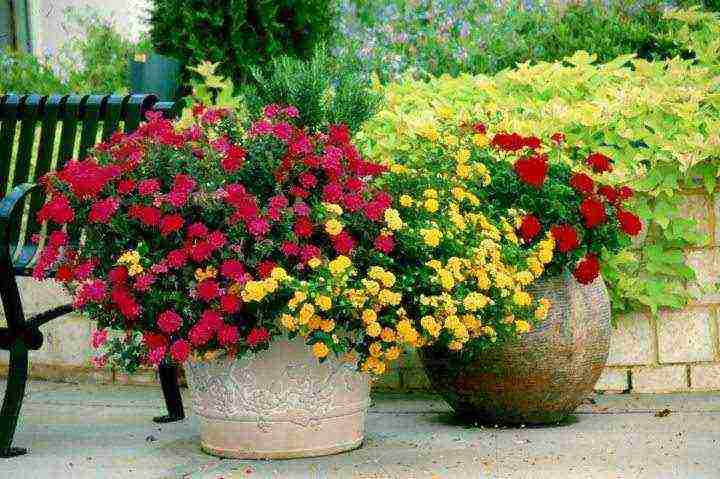
Now breeders have bred more than 10,000 varieties of pelargonium, which differ in the shape and color of flowers and leaves, trunk height and other characteristics of the variety. Some varieties were bred specifically for greenhouses.
Of the variety of species for home cultivation, they are most often used garden geranium or pelargonium zonal.
The healing properties of the plant
Almost all zonal pelargoniums have a specific leaf aroma.
This smell is able to scare off some insects, for example, moths, for which it has taken root on home windowsills.
Also, the aroma can be used in herbal medicine for the prevention and treatment of neuroses, stress, insomnia.
Useful properties of geranium:
 they are used to extract essential oils for the cosmetic industry,
they are used to extract essential oils for the cosmetic industry,- leaves can be dried and added to tea, made sachets,
- geranium cleans the air in the apartment,
- has antibacterial properties,
- accelerates the healing process of wounds,
- has a beneficial effect on the human nervous system,
- root extract is used in the treatment of diseases of the respiratory system.
How to organize therapeutic sessions of herbal medicine?
Such sessions can be done independently at home.
This requires:
- sit next to a flower,
- touch its leaves,
- feel the aroma by inhaling deeply 2-3 times,
- and then breathe at your usual pace.
You can observe positive changes in 10-14 days.
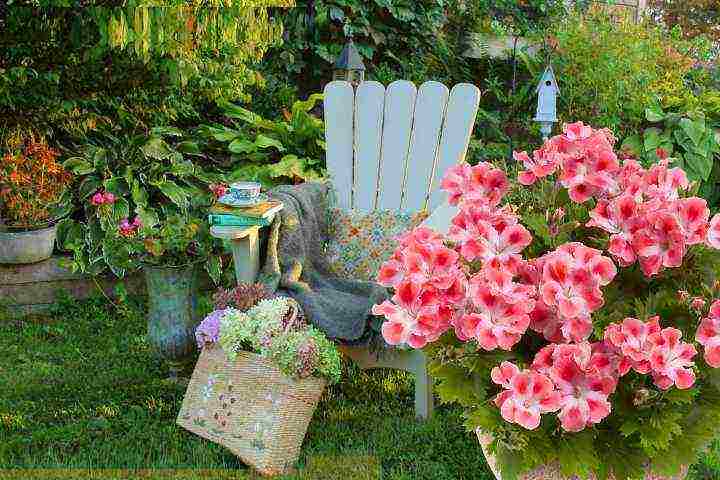
Appearance
Pelargonium zonal - the most popular type due to its unpretentiousness and durability, retains decorative properties for up to 20 years.
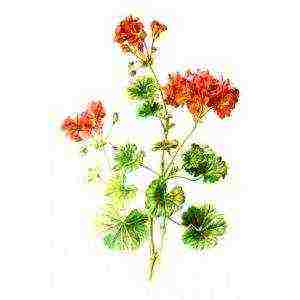 Height. In open ground or in natural conditions, it can grow up to one and a half meters in height, at home - no more than half a meter.
Height. In open ground or in natural conditions, it can grow up to one and a half meters in height, at home - no more than half a meter.
Crown of bushes lends itself well to formation, it can be grown both as a shrub and as a tree.
Leaves. On round leaves, circles in the shape of a horseshoe or bagel are visible, which differ from the leaf itself, can be either darker or lighter, there are even contrasting shades of half rings.
Bloom Pelargonium has a long duration from spring to autumn, there are species that, with proper care, can bloom all year round. The flowers themselves are collected in large inflorescences in the form of a ball.
Coloration depends on the type of plant.
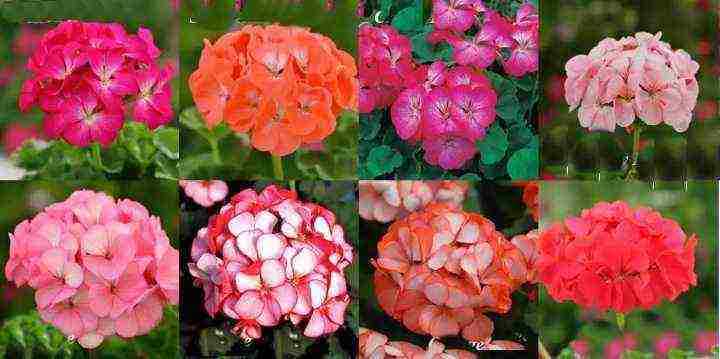
Coloring can be:
- white,
- red,
- pink,
- purple or even
- two-tone.
On the petals themselves, there may be additional details in the form of spots, strokes or a contrasting edge.
Classification
A plant can be classified according to various criteria.
By stem height
Plants are divided into:
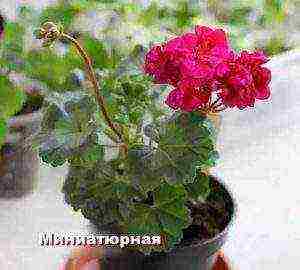 tall specimens (up to 42 centimeters high),
tall specimens (up to 42 centimeters high),- medium-sized (grow up to 40 centimeters),
- undersized (no more than 20 centimeters in height) and
- miniature (only up to 5 centimeters)
By the number of petals
You can distinguish:
- simple flowers up to 5 petals,
- semi-double have 5-8 petals and
- Terry - these are already lush flowers with more than 8 petals.
By the color of the petals and the shape of the flowers
You can distinguish:
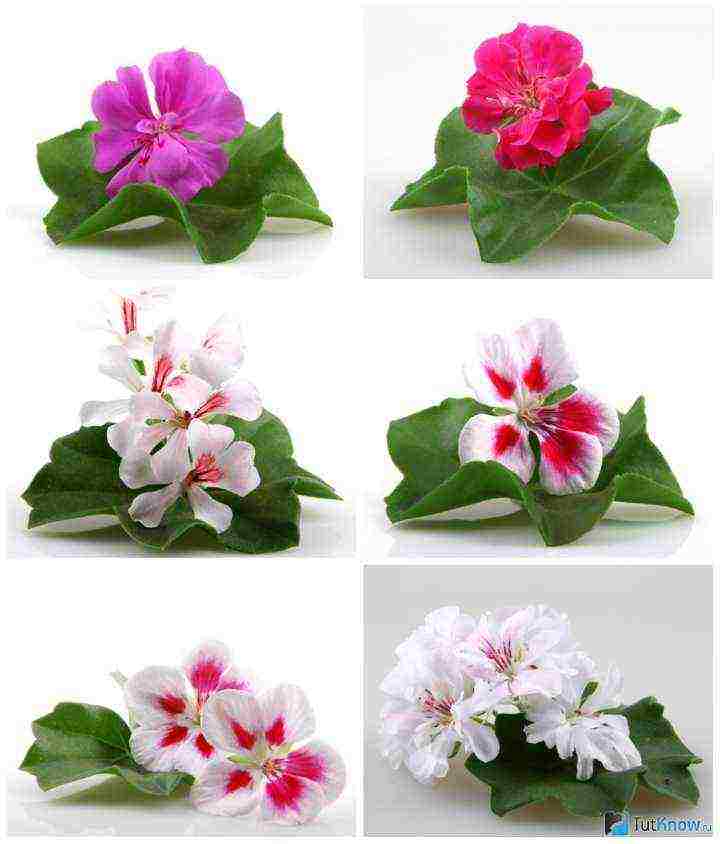 simple flowers forming large inflorescences - umbrellas are bouquet varieties
simple flowers forming large inflorescences - umbrellas are bouquet varieties- flowers with pointed petals and heavily dissected leaves - star varieties
- flowers with narrow petals, often twisted to the center - cactus-flowering varieties.
- Bicolor flowers with a white center and crimson edges of the petals - phlox-flowered varieties
- Flowers, the shape of which resembles tulip buds, due to the fact that the flower never opens up to the end - tulip-like varieties
- Flowers resembling small roses, lush with half-opened petals, curled towards the center - rosebutton.
- Flowers with wavy petals, dissected along the edges, resembling a carnation - carnation
By the shape and color of foliage
You can distinguish:
 green varieties with ordinary green leaves of varying degrees of color intensity and dark or light circles on the leaves in the shape of a horseshoe.
green varieties with ordinary green leaves of varying degrees of color intensity and dark or light circles on the leaves in the shape of a horseshoe.- variegated varieties, which are grown just for the sake of decorative foliage, since the flowers themselves are small and inconspicuous, but the leaves are striking in a variety of shapes and colors.
The circles on the leaves can be located not only in the form of a zone, but also in the form of a sector.
And its shades in combination with leaves can be completely unimaginable - pink, bronze, brown, silver, white, yellow, as well as combine several shades.
Varieties of pelargonium zonal
The most popular cultivars are identified.
Meteor
Differs in rich dark green leaves, on which the zoning zone is practically invisible. The flowers are bright red with dark longitudinal stripes. Perfect for gardening.

Rocky Mountain
It is a tall plant with large white flowers, in some varieties they can be lilac or salmon in color.

Rumba Fire
It features rich, almost luminous red flowers and an average bush height.
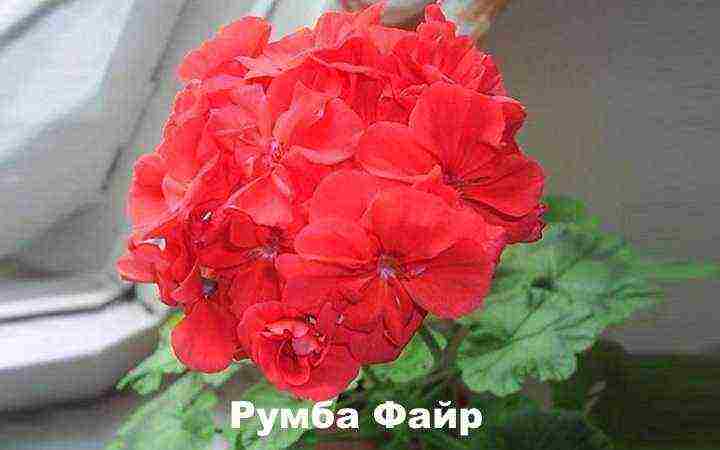
Bravo Pastel
It has pastel pink-white flowers with a crimson transition to the center of the flower.
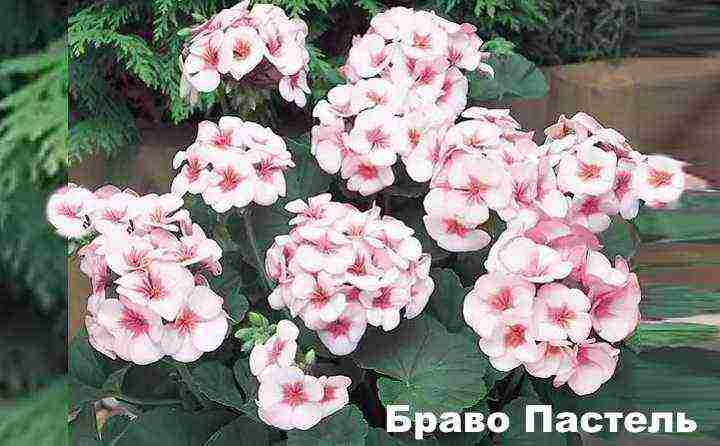
Merkur 2000
With huge bright red flowers with a relatively small own growth.
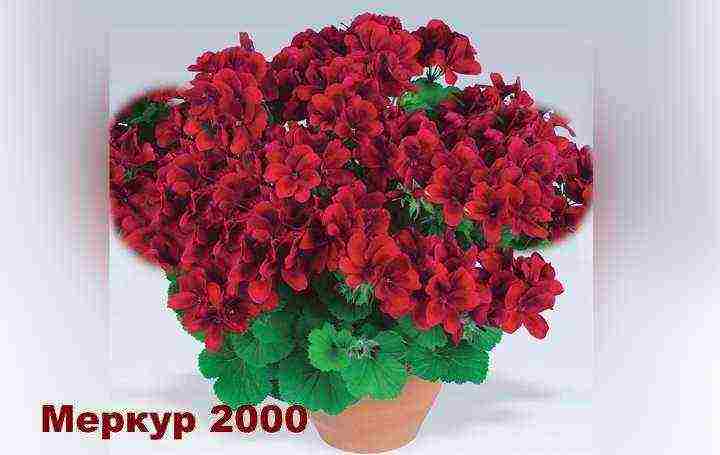
Alba
With a small stature, it has large white flowers.
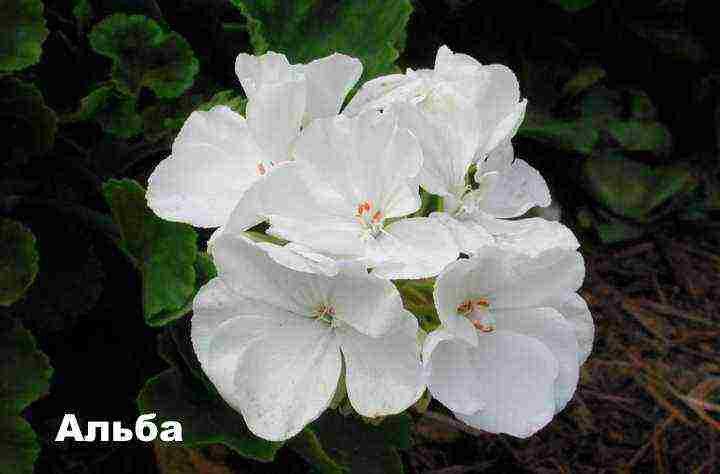
Sharman 98
Differs in flowers of a delicate pink, almost salmon color.
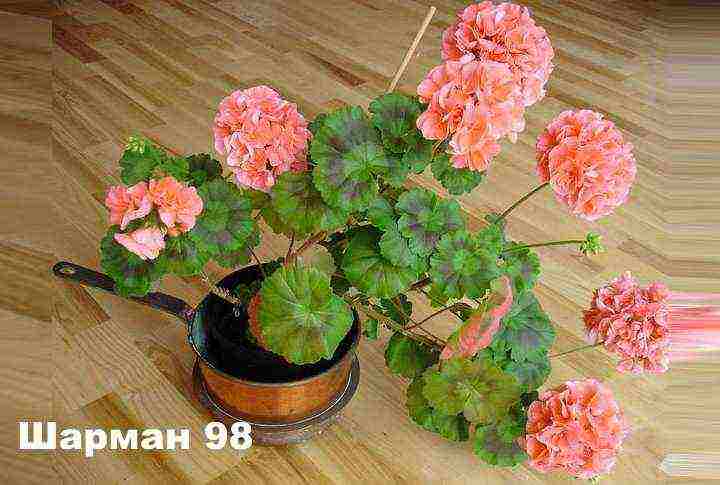
Growing and care
Favorable conditions
For the growth and flowering of a plant, not so much is needed - proper watering and sufficient lighting, and your pelargonium will delight you with lush flowering for a long time.
Lighting
In order for the plant to grow and form a lush green crown and abundant inflorescences, it needs bright light 4-8 hours a day, the ideal place is the south side.
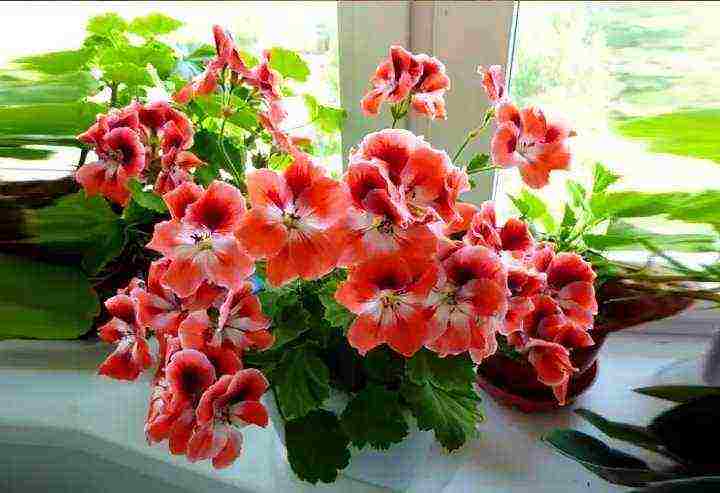
On hot days, the plant should be darkened to avoid sunburn. In summer, it is optimal to maintain a temperature of 20-23 degrees during the day and 12-15 at night.
In winter, it is optimal to keep the flower at a temperature of 12-20 degrees. Blooming geraniums must be protected from drafts and from contact with cold glass windows.
Watering
Watering should be regular and dosed, since if there is too much water, the roots may start to rot, if there is not enough water, the leaves will wither and turn yellow.
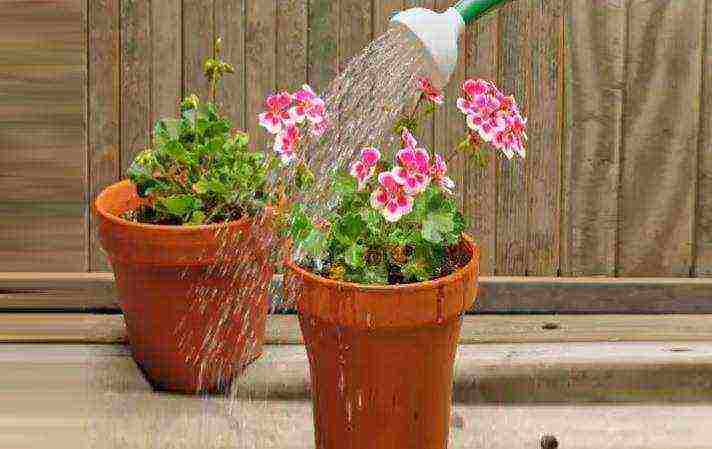
It is necessary to water abundantly only after the topsoil dries out. In winter, you can water once every half a month.
There is no need to spray the plant because it is tolerant of air humidity, and water on the leaves can lead to unsightly stains.
In winter, when the air in the apartments is dry, the plant should be placed on a tray with expanded clay, which is important to periodically moisten.
Transfer
Pelargonium zonal grows quickly enough, so periodic transplantation into a new, more spacious pot is required.
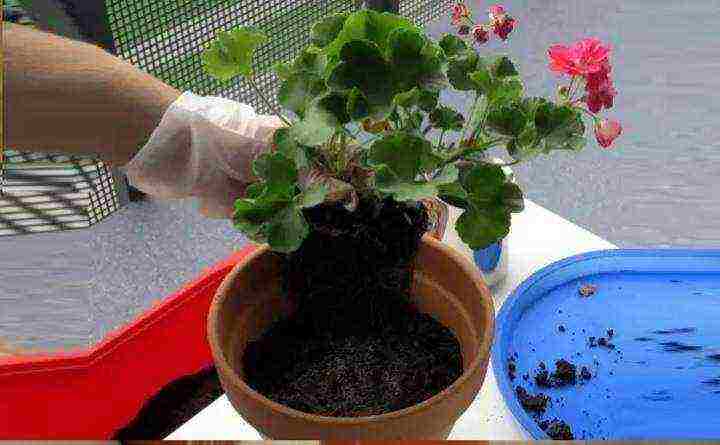
You can transplant the plant at any convenient time from spring to autumn.When kept in open ground, the plant should also be transplanted into a pot for the winter and brought indoors.
Young plants should be transplanted into slightly larger containers a couple of centimeters in diameter. Adults - in pots of the same volume, changing only completely the soil mixture, which usually includes peat, loamy soil, sand, perlite and charcoal.
Pruning
Flowers appear on young shoots, so it is important to carry out pruning in a timely manner to form the crown, if it is not carried out, the plant will stretch out and lose its decorative effect.
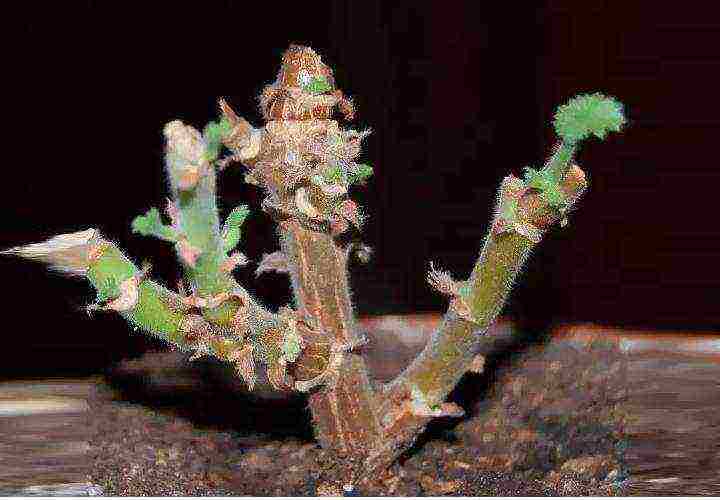
Since the plant grows very quickly, it is important to prune and pinch the plants regularly.
Reproduction of pelargonium
In the conditions of indoor and garden floriculture, zonal pelargonium is propagated mainly either by cuttings or by seeds.
Cuttings
Propagation by cuttings is a simple and popular method. Cutting is also a good option to rejuvenate the plant, while the young plant retains all the species characteristics of the mother.
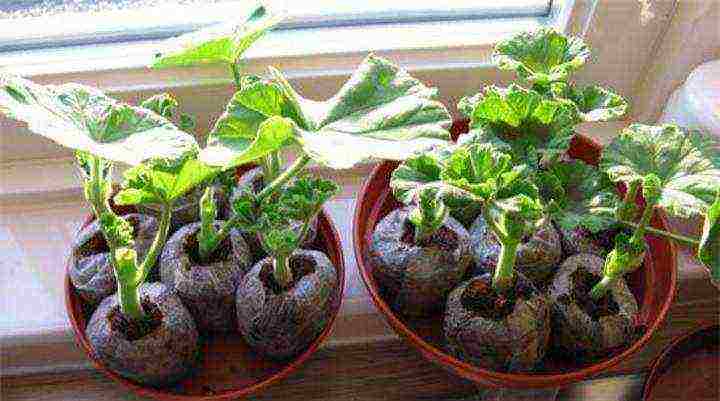
As cuttings, you can use the shoots left over from pruning the plant. For the cutting, the tip of the shoot 5-15 centimeters with a leaf knot is suitable, it is necessary to cut it below it by 0.5 centimeters below the knot.
- From the cutting, you need to cut off all the remnants of the lower flowers and leaves, if they are preserved.
- Dry the cut of the cutting in the air for a couple of hours and root it in water or soil (a mixture of peat and sand).
- The soil with cuttings must be kept moist as it dries, but water must not be stagnant. Roots usually appear in 10-14 days.
- The hardened seedlings are fed with a complex of fertilizers, and after a while they are transferred into permanent pots.
Seeds
Growing from seeds cannot guarantee the preservation of the species characteristics of the plants. It is better to plant pelargonium seeds at the end of winter, then in the spring the sprouts will gain strength and in the summer they will be able to please with flowering.

In general, seeds can be planted at least all year round.
The seeds of the plant themselves are large enough, oblong in shape and have a dense shell.
Therefore, before planting, it is better to carry out the scarification procedure - to grind the planting material with a file or sandpaper, soak the seeds in water at room temperature.
This will speed up the germination procedure by 10 times. If you buy seeds in a store, then you can skip the preparation, they already sell processed material for planting.
Seeds should be sown on a mixture of peat soil and perlite, which must first be sterilized. And sprinkle on top with a layer of a couple of millimeters.
For rooting, the seeds should be kept warm, with diffused lighting, regularly watered with a spray bottle with water dissolved in it Biohumus for seedlings.

The first sprouts hatch in a couple of weeks. Young plants should dive into separate pots after the appearance of two pairs of leaves.
Germination devices
Good for seed germination regular cotton pads... To create the necessary structure for germinating seeds, it is necessary to wet one disk well with water, put the seed on it, and cover it with another cotton pad.
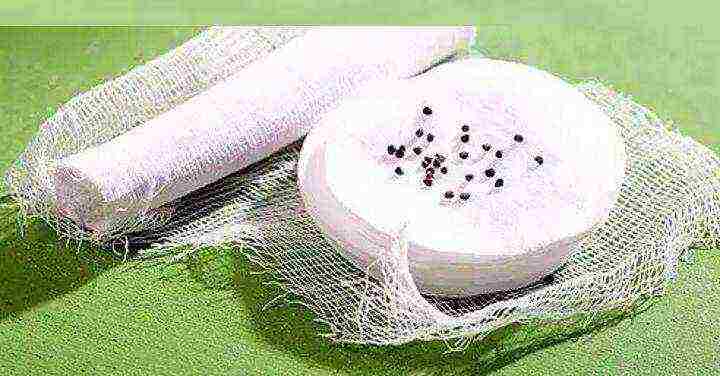
Place this device in a container with a lid and transfer to a warm place. Periodically, you need to ventilate by opening the lid of the structure, and daily check for hatching seeds. As soon as a sprout appears from the seed, it should be planted in a previously prepared substrate.
Pests and diseases
Pelargonium may show signs of damage by such insects:
- spider mites,
- mealybug
- aphids,
- thrips.
If a lesion is detected, it is necessary to treat the affected plant with insecticides.
Most often the plant is affected whitefly... She lays her larvae on the back of the leaf.
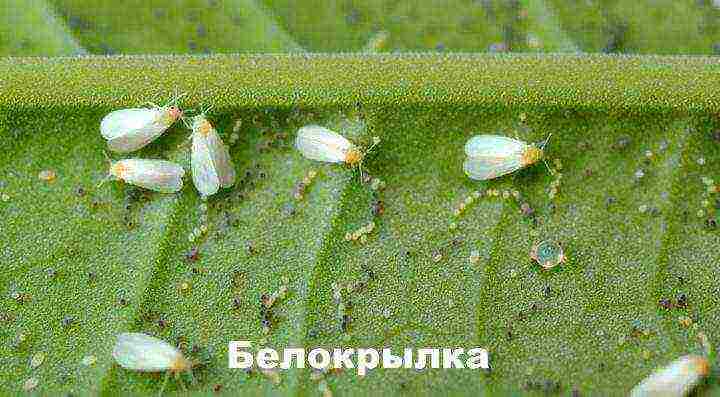
You can fight it with soapy water.The bush must be treated with soapy water and covered with polyethylene for several days.
In case of severe damage, treat with special chemical preparations.
The plant can be affected by a dangerous disease - black leg, most often this is due to excessive watering, improper temperature conditions.
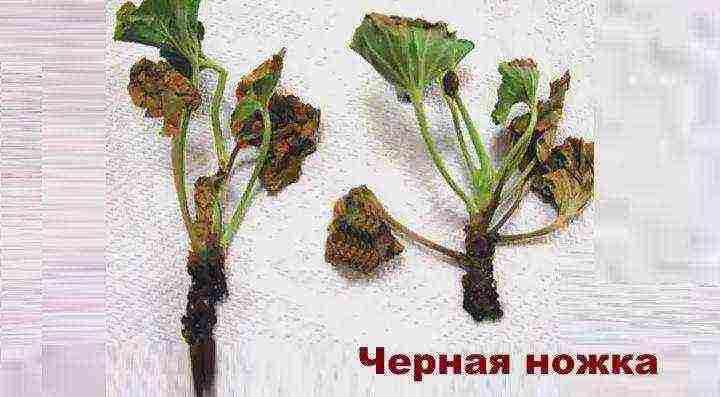
If you notice a gray bloom on the leaves on the plant, while they turn yellow with brown spots, it is likely that the plant is affected mold... It is important to destroy the affected leaves and treat the plant with fungicides.
As you can see, it is quite easy to grow zonal pelargonium and even a novice gardener can do it, since it is not whimsical enough to the conditions of detention, but at the same time it will delight you with furry and beautiful flowering at home, on a balcony or in a summer cottage for a long time.
TOP proven suburban shops in the Russian Federation - Choose, buy!
- - "Garden and Vegetable Garden" - Gardens of Russia is an online store of seeds and seedlings.
- - "Becker" is a popular store of seedlings, seeds, bulbs, delivery all over Russia!
